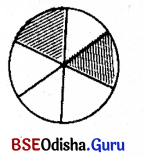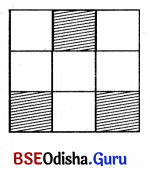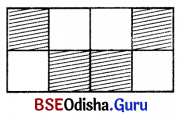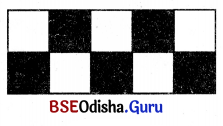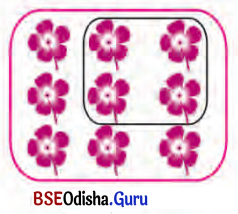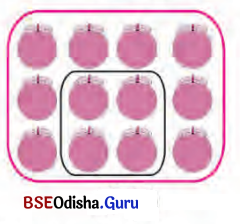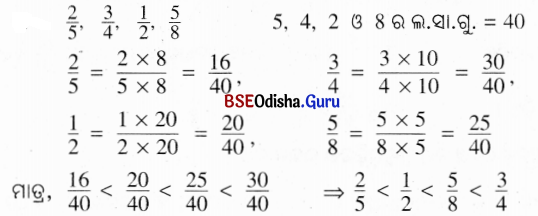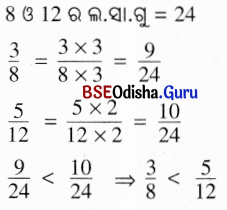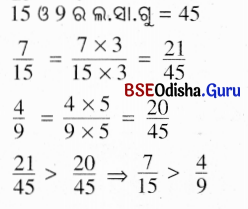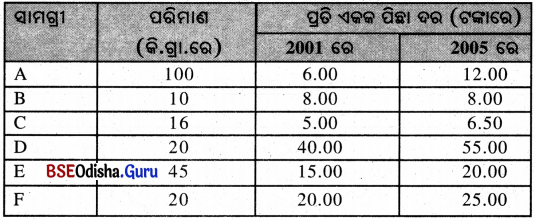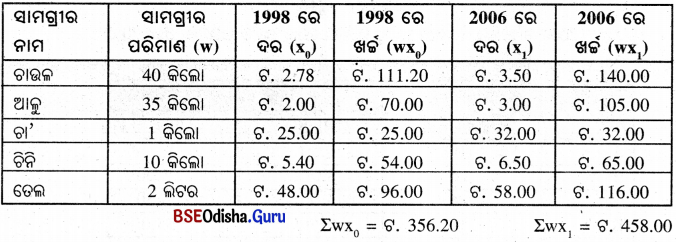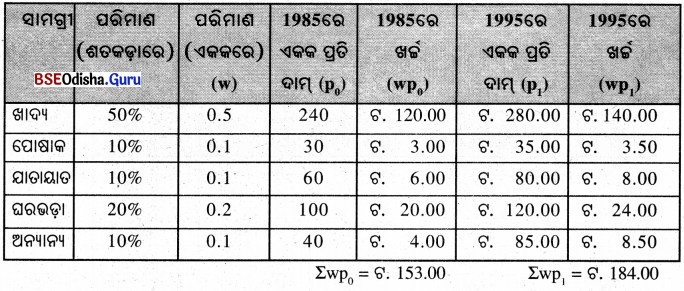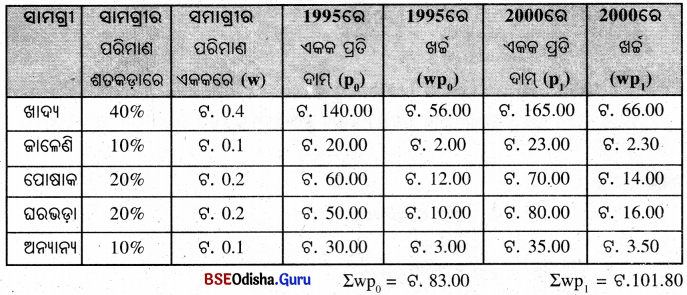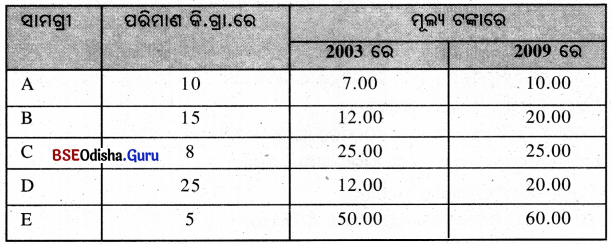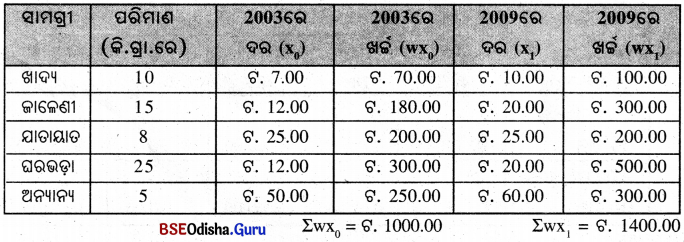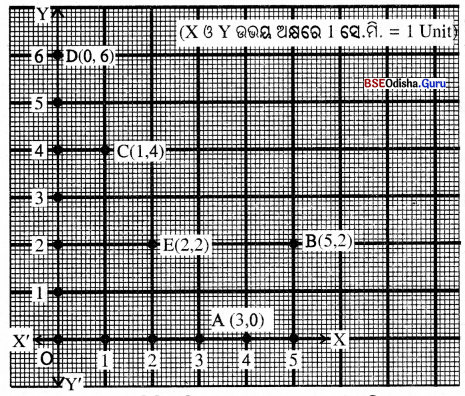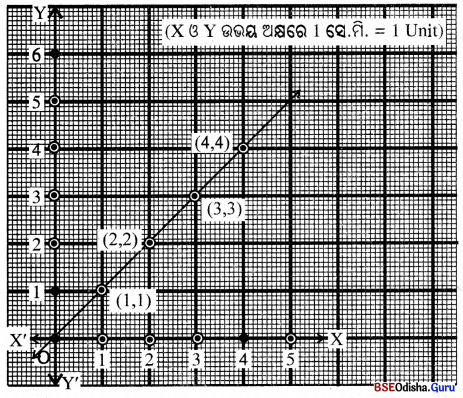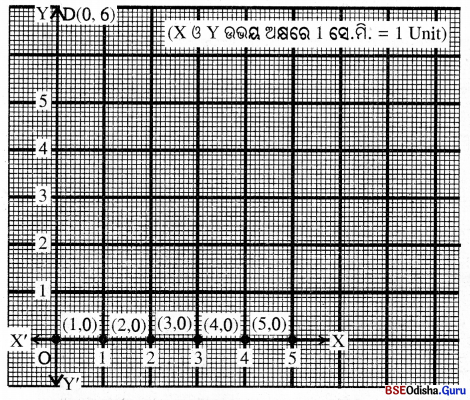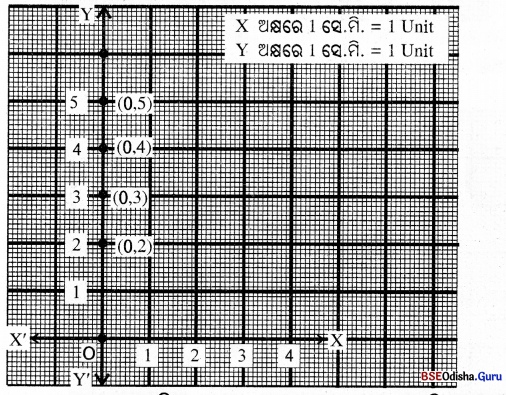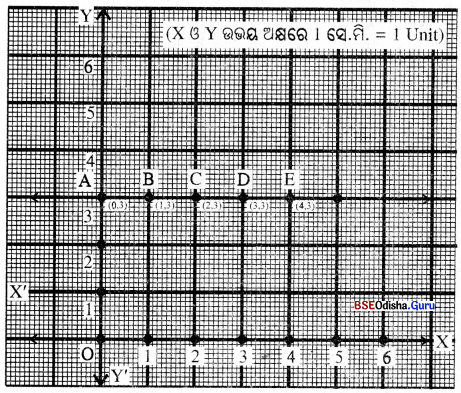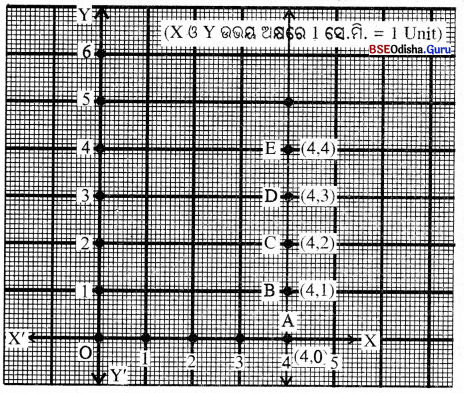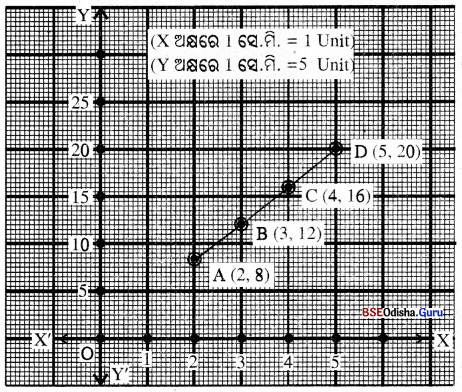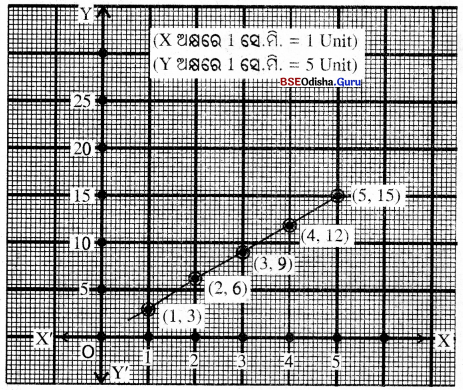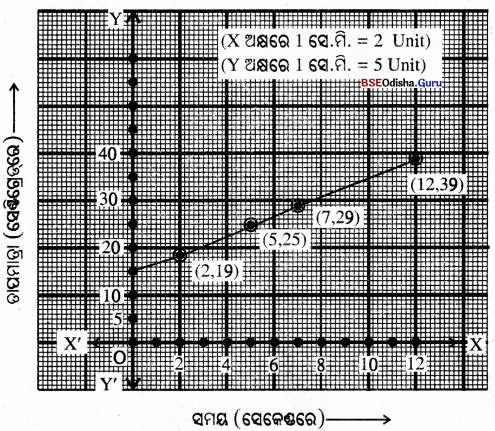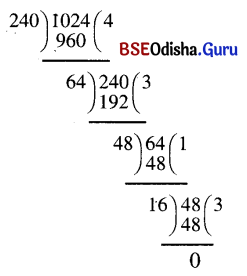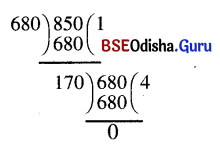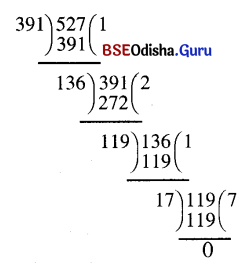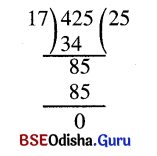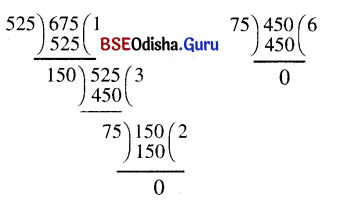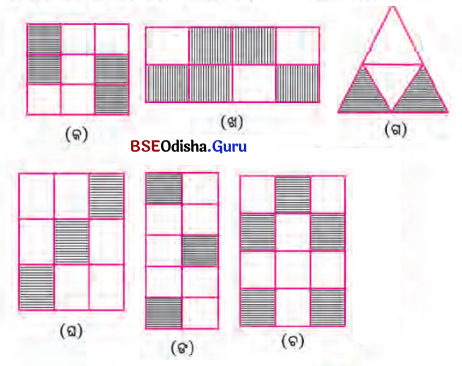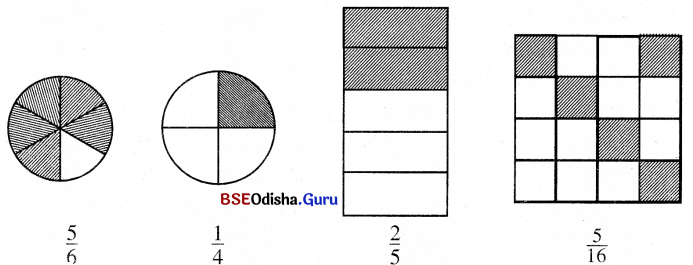Odisha State Board CHSE Odisha Class 12 History Solutions Chapter 7 ପରିବ୍ରାଜକଙ୍କ ଚକ୍ଷୁରେ ଭାରତୀୟ ସମାଜ ସମ୍ପର୍କରେ ଧାରଣା Short & Long Answer Questions.
CHSE Odisha 12th Class History Chapter 7 Short & Long Answer Questions in Odia Medium
ସଂକ୍ଷିପ୍ତ ଉତ୍ତରମୂଳକ ପ୍ରଶ୍ନୋତ୍ତର
A. ଦୁଇଟି / ତିନୋଟି ବାକ୍ୟରେ ଉତ୍ତର ଦିଅ ।
୧। ଆଲ୍ବିରୁଣୀ କିଏ ? ତାଙ୍କଦ୍ବାରା ଲିଖ ପ୍ରସିଦ୍ଧ ପୁସ୍ତକର ନାମ କ’ଣ ?
Answer:
ଏକାଦଶ ଶତାବ୍ଦୀରେ ଆଲ୍ବିରୁଣୀ ମଧ୍ଯ ଏସିଆର ଜଣେ ବିଦ୍ବାନ୍ ଥିଲେ । ତାଙ୍କଦ୍ବାରା ଲିଖ୍ତ ପୁସ୍ତକର ନାମ ଥିଲା ‘କିତାବ୍-ଉଲ୍-ହିନ୍ଦ୍’ ।
୨। ଆଲ୍ବିରୁଣୀ କେବେ ଓ କାହାଙ୍କଦ୍ଵାରା କେଉଁଠାରୁ ବନ୍ଦୀହୋଇ ଗଜନୀ ଆସିଥିଲେ ?
Answer:
୧୦୧୭ ଖ୍ରୀ.ଅ.ରେ ଆଲବିରୁଣୀ ଗଜନୀର ସୁଲତାନ୍ ମାମୁଦ୍ରଙ୍କଦ୍ଵାରା ବନ୍ଦୀ ହୋଇ ଗଜନୀକୁ ଆସିଥିଲେ । ମାମୁଦ୍ ତାଙ୍କୁ ଖୁରିଜମୂରୁ ବନ୍ଦୀ କରିଥିଲେ ।
![]()
୩ । ଇବନ ବତୁତାଙ୍କୁ କିଏ ତାଙ୍କର ଭ୍ରମଣକାହାଣୀ ଲେଖିବାକୁ ନିର୍ଦ୍ଦେଶ ଦେଇଥିଲେ । ଏଥିପାଇଁ ସେ କ’ଣ କରିଥିଲେ ?
Answer:
ଇବନ ବତୁତାଙ୍କୁ ମରକ୍କୋର ସୁଲତାନ ଆବୁ ଇନାମ ତାଙ୍କର ଭ୍ରମଣ କାହାଣୀ ଲେଖିବାକୁ ନିର୍ଦ୍ଦେଶ ଦେଇଥିଲେ । ଏଥିପାଇଁ ସେ ଇବାନ ଜୁଡ଼ାଏ ନାମକ ଜଣେ ମୁସଲିମ୍ ପଣ୍ଡିତଙ୍କୁ ନିଯୁକ୍ତି ଦେଇଥିଲେ ।
୪ । ସେ ସମୟର ଦୁଇଟି ପ୍ରଧାନ ସହରର ନାମ ଲେଖ ।
Answer:
ଇବନ ବତ୍ରୁତା ତାଙ୍କର ପୁସ୍ତକ ‘ରିହାଲା’ରେ ଭାରତର ନଡ଼ିଆ ଓ ପାନକୁ ବେଶୀ ଗୁରୁତ୍ଵ ଦେଇଥିଲେ । ସେ ସମୟର ଦୁଇଟି ପ୍ରଧାନ ସହରର ନାମ ହେଲା – ଦିଲ୍ଲୀ, ଦୌଲତାବାଦ ।
୫। ଇବନ ବତ୍ରୁତାଙ୍କର ପ୍ରକୃତ ନାମ କ’ଣ ଥିଲା ? ସେ କେଉଁ ଅଞ୍ଚଳର ବାସିନ୍ଦା ଥିଲେ ?
Answer:
ଇବନ ବତ୍ରୁତାଙ୍କର ପ୍ରକୃତ ନାମ ଆବୁ ଅବଦୁଲ୍ଲା ମହମ୍ମଦ ଥିଲା ସେ ମରକ୍କୋ ସହରର ବାସିନ୍ଦା ଥିଲେ ।
୬ | ଇବନ ବତୁତା କେବେ କେଉଁଠାରେ ଜନ୍ମଗ୍ରହଣ କରିଥିଲେ ?
Answer:
ଇବନ ବତୁତା ୧୩୦୪ ମସିହା ଫେବୃୟାରୀ ୨୪ ତାରିଖରେ ମରକ୍ ସହରର ତାଞ୍ଜିଆରଠାରେ ଜନ୍ମଗ୍ରହଣ କରିଥିଲେ ।
୭ । ଇବନ ବତୁତା ଲେଖୁଥିବା ପୁସ୍ତକ ‘ରହାଲା’ରେ ଦିଲ୍ଲୀର କେଉଁ ସମ୍ରାଟଙ୍କ ବିଷୟରେ ସବିଶେଷ ତଥ୍ୟ ମିଳିଥାଏ । ଏହି ପୁସ୍ତକ ସେ କେଉଁ ଭାଷାରେ ଲେଖିଥିଲେ ?
Answer:
ଇବନ ବତ୍ରୁତା ଲେଖୁଥିବା ପୁସ୍ତକ ‘ରିହାଲା’ରେ ଦିଲ୍ଲୀର ସମ୍ରାଟ ମହମ୍ମଦ ବିନ୍ ତୋଗଲକ୍ଙ୍କ ବିଷୟରେ ସବିଶେଷ ତଥ୍ୟ ମିଳିଥାଏ । ଏହି ପୁସ୍ତକକୁ ସେ ଆରବିକ୍ ଭାଷାରେ ଲେଖିଥିଲେ ।
୮ | ଫ୍ରାଙ୍କୋଇସ୍ ବଣ୍ଡିୟର କେବେ କେଉଁଠାରେ ଜନ୍ମଗ୍ରହଣ କରିଥିଲେ ? ସେ ବୃତ୍ତିରେ କ’ଣ ଥିଲେ ?
Answer:
ଫ୍ରାଙ୍କୋଇସ୍ ବଣ୍ଠିୟର୍ ୧୬୨୦ ଖ୍ରୀ.ଅ. ସେପ୍ଟେମ୍ବର ୨୫ ତାରିଖରେ ଫ୍ରାନ୍ସର ଗୋମର୍ଡ ନିକଟରେ ଯୋଏ ନାମକ ଗ୍ରାମରେ ଜନ୍ମଗ୍ରହଣ କରିଥିଲେ । ସେ ବୃତ୍ତିରେ ଡାକ୍ତର ଥିଲେ ।
୯। କେଉଁ ସମ୍ରାଟଙ୍କ ଅନୁରୋଧକ୍ରମେ ଫ୍ରାଙ୍କୋଇସ୍ ବର୍ଷିୟର ତାଙ୍କର ପ୍ରସିଦ୍ଧ କେଉଁ ପୁସ୍ତକଟିକୁ ଲେଖୁଥିଲେ ?
Answer:
ଫ୍ରାନ୍ସ ସମ୍ରାଟ ଚତୁର୍ଦ୍ଦଶ ଲୁଇଙ୍କ ଅନୁରୋଧକ୍ରମେ ଫ୍ରାଙ୍କୋଇସ୍ ବର୍ଷିୟର ତାଙ୍କର ପ୍ରସିଦ୍ଧ ପୁସ୍ତକ ‘ମୋଗଲ ସାମ୍ରାଜ୍ୟରେ ଭ୍ରମଣ’ ପୁସ୍ତକଟି ଲେଖୁଥିଲେ ।
![]()
୧୦ । ଫ୍ରାଙ୍କୋଇସ୍ ବର୍ଷିୟରଙ୍କ ପୁସ୍ତକ ‘ମୋଗଲ ସାମ୍ରାଜ୍ୟରେ ଭ୍ରମଣ’ କେଉଁ ଭାଷାରେ ରଚିତ ହୋଇଥିଲା ଏବଂ ପରେ ଏହାକୁ କିଏ ଇଂରାଜୀ ଭାଷାରେ ଅନୁବାଦ କରିଥିଲେ ?
Answer:
ଫ୍ରାଙ୍କୋଇସ୍ ବର୍ଷିୟରଙ୍କ ପୁସ୍ତକ ‘ମୋଗଲ ସାମ୍ରାଜ୍ୟରେ ଭ୍ରମଣ’ ଫ୍ରେଞ୍ଚ ଭାଷାରେ ରଚିତ ହୋଇଥିଲା ଏବଂ ପରେ ଏହାକୁ ଓଲ୍ଡନେବର୍ଗ ନାମକ ଜଣେ ଲେଖକ ଇଂରାଜୀ ଭାଷାରେ ଅନୁବାଦ କରିଥିଲେ ।
B. ପାଞ୍ଚଟି/ ଛଅଟି ବାକ୍ୟରେ ଉତ୍ତର ଦିଅ ।
୧। କିତାବ୍-ଉଲ୍-ହିନ୍ଦ୍ :
Answer:
କିତାବ୍-ଉଲ୍-ହିନ୍ଦ୍ ପୁସ୍ତକଟି ରାଷ୍ଟ୍ରଦୂତ ଆଲ୍ବିରୁଣୀଙ୍କ ଏକ ବଳିଷ୍ଠ କୃତି ଯାହାକୁ ସେ ୧୦୩୧ ଖ୍ରୀ.ଅ.ରେ ଗଜନୀରେ ଥିଲାବେଳେ ଲେଖୁଥିଲେ । ଆରବିକ୍ ଭାଷାରେ ଲିଖ୍ ଏହି ପୁସ୍ତକକୁ ତାରିଖ୍-ଉଲ୍-ହିନ୍ଦୁ ମଧ୍ୟ କୁହାଯାଏ । ଏହି ପୁସ୍ତକଟି ୮୦ଟି ଅଧ୍ୟାୟରେ ବିଭକ୍ତ । ଏଥୁରେ ହିନ୍ଦୁଧର୍ମ, ଦର୍ଶନ, ପର୍ବପର୍ବାଣି, ପ୍ରଥା ଓ ପରମ୍ପରା, ଭାରତୀୟମାନଙ୍କର ସାମାଜିକ, ଆର୍ଥିକ ଏବଂ ରାଜନୈତିକ ଜୀବନ, ଭୂଗୋଳ, ଦେବାଦେବୀ ମୂର୍ତ୍ତି, ଧର୍ମୀୟ ପରମ୍ପରା, ସାହିତ୍ୟ, ଆଇନ, କଳାସ୍ଥାପତ୍ୟ, ଭାସ୍କର୍ଯ୍ୟ ଇତ୍ୟାଦି ବିଷୟରେ ବର୍ଣ୍ଣିତ ଅଛି । ଏହି ପୁସ୍ତକଟି ଲେଖୁବା ମୂଳରେ ଆଲ୍ବିରୁଣୀଙ୍କର ଦୁଇଟି ମୁଖ୍ୟ ଉଦ୍ଦେଶ୍ୟ ଥିଲା । ପ୍ରଥମତଃ, ଯେଉଁମାନେ ହିନ୍ଦୁତ୍ୱ ଏବଂ ଦର୍ଶନ ଉପରେ ଜାଣିବାକୁ ଚାହିଁବେ ସେମାନଙ୍କୁ ଏହି ପୁସ୍ତକଟି ସାହାଯ୍ୟ କରିବ । ଦ୍ଵିତୀୟତଃ, ଯେଉଁ ବ୍ୟକ୍ତି ତାଙ୍କଠାରୁ ଭିନ୍ନ ମତ ପୋଷଣ କରିବ ତାକୁ ସେ ତାଙ୍କ ପୁସ୍ତକରେ ସ୍ଥାନ ଦେବେ ।
୨। ଆଲ୍ବିରୁଣୀ :
Answer:
ଏକାଦଶ ଶତାବ୍ଦୀରେ ଭାରତ ଭ୍ରମଣରେ ଆସିଥିବା ବୈଦେଶିକ ପରିବ୍ରାଜକମାନଙ୍କ ମଧ୍ୟରୁ ଆଲ୍ବିରୁଣୀ ଥିଲେ ଅନ୍ୟତମ । ତାଙ୍କର ପୂରାନାମ ଥିଲା ମହମ୍ମଦ ଇବାନ ଅହମ୍ମଦ ଆବୁ ରାଏହାନ୍ ଆଲ୍ବିରୁଣୀ । ସେ ୯୭୩ ଖ୍ରୀ.ଅ. ସେପ୍ଟେମ୍ବର ୪ ତାରିଖରେ ଉବେକିସ୍ଥାନର ଖୁରିଜମ୍ଠାରେ ଜନ୍ମଗ୍ରହଣ କରିଥିଲେ । ୧୦୧୭ ଖ୍ରୀ.ଅ.ରେ ଗଜନୀର ସୁଲତାନ୍ ମାମୁଦ୍ ଖୁରିଜମ୍ ଅଧୂକାର କରି ତାଙ୍କୁ ବନ୍ଦୀ କରି ଗଜନୀ ଆଣିଥିଲେ । କିନ୍ତୁ ଆଲବିରୁଣୀଙ୍କ ଜ୍ଞାନ ଓ ପ୍ରତିଭାରେ ପ୍ରଭାବିତ ହୋଇ ମାମୁଦ୍ ତାଙ୍କୁ ମୁକ୍ତ କରିବା ସହ ସାହା-ଇ-ଖୁରିଜମ୍ ଉପାଧିରେ ସମ୍ମାନୀତ କରିଥିଲେ । ୧୦୩୧ ଖ୍ରୀ.ଅ.ରେ ଗଜନୀରେ ଥିଲାବେଳେ ଆଲ୍ବିରୁଣୀ କିତାବ୍-ଉଲ୍-ହିନ୍ଦ୍ ନାମକ ଏକ ପୁସ୍ତକ ଲେଖୁଥିଲେ । ଆରବିକ୍ ଭାଷାରେ ଲିଖ୍ ଏହି ପୁସ୍ତକଟିକୁ ମଧ୍ୟ ତାରିଖ-ଉଲ୍-ହିନ୍ଦ୍ କୁହାଯାଏ । ଏହି ପୁସ୍ତକଟି ୮୦ଟି ଅଧ୍ୟାୟରେ ବିଭକ୍ତ । ଉକ୍ତ ପୁସ୍ତକରୁ ସେ ସମୟର ଭାରତୀୟମାନଙ୍କର ଜୀବନଶୈଳୀ ଉପରେ ଏକ ସ୍ପଷ୍ଟ ଚିତ୍ର ଦେଖିବାକୁ ମିଳିଥାଏ । ୧୦୪୮ ଖ୍ରୀ.ଅ.ରେ ଏହି ମହାନ୍ ପଣ୍ଡିତଙ୍କର ଦେହାନ୍ତ ହୋଇଥିଲା ।
![]()
୩ । ରିହାଲା :
Answer:
‘ରିହାଲା’ ଗ୍ରନ୍ଥଟି ଚତୁର୍ଦ୍ଦଶ ଶତାବ୍ଦୀର ବୈଦେଶିକ ପରିବ୍ରାଜକ ଇବନ ବତୁତାଙ୍କଦ୍ୱାରା ଲିଖ୍ ହୋଇଅଛି । ମରକ୍କୋର ସୁଲତାନ୍ ଆବୁ ଇନାମଙ୍କ ନିର୍ଦ୍ଦେଶରେ ୧୩୫୪ ଖ୍ରୀ.ଅ.ରେ ଆରମ୍ଭ ହୋଇଥିବା ଏହି ପୁସ୍ତକଟି ୧୩୫୫ ଖ୍ରୀ.ଅ.ରେ ପୂର୍ଣ୍ଣତା ଲାଭ କରିଥିଲା । ଏହା ଆରବିକ୍ ଭାଷାରେ ଲେଖାଯାଇଥିଲା । ସେ ଏଥିରେ ଭାରତୀୟମାନଙ୍କର ଜୀବନଶୈଳୀ, ତଥା ତତ୍କାଳୀନ ସାମାଜିକ ଅବସ୍ଥାକୁ ଅତି ଚମତ୍କାର ଶୈଳୀରେ ଫୁଟାଇପାରିଛନ୍ତି । ସେ ଏହି ପୁସ୍ତକରେ ଭାରତର ନଡ଼ିଆ ଓ ପାନକୁ
୪ । ଇବନ ବତୁତା :
Answer:
ଚତୁର୍ଦ୍ଦଶ ଶତାବ୍ଦୀରେ ଭାରତ ଭ୍ରମଣରେ ଆସିଥିବା ବୈଦେଶିକ ପରିବ୍ରାଜକମାନଙ୍କ ମଧ୍ୟରୁ ଇବନ ବତ୍ରୁତା ଥିଲେ ଅନ୍ୟତମ ! ତାଙ୍କର ପ୍ରକୃତ ନାମ ଥିଲା ଆବୁ ଅବଦୁଲ୍ଲା ମହମ୍ମଦ । ସେ ୧୩୦୪ ଖ୍ରୀ.ଅ. ଫେବୃୟାରୀ ୨୪ ତାରିଖରେ ପ୍ରସିଦ୍ଧ ମରକ୍କୋ ସହରର ତାଞ୍ଜିଆଠାରେ ଜନ୍ମଗ୍ରହଣ କରିଥିଲେ । ତାଙ୍କ ପରିବାର ଇସଲାମିକ୍ ଆଇନ ‘ଶାରିଆତ୍’ର ମୁଖ୍ୟ ତର୍ଜମାକାରୀ ଥିଲେ । ୧୩୨୫ ଖ୍ରୀ.ଅ.ରେ ଇବନ ବତୁତା ତାଙ୍କର ପ୍ରଥମ ମକ୍କା ଯାତ୍ରା ଆରମ୍ଭ କରିଥିଲେ । ଏହାପରେ ସେ ସିରିଆ, ଇରାନ୍, ପର୍ସିଆ, ୟେମେନ୍, ଓମାନ୍ ଏବଂ ପୂର୍ବ ଆଫ୍ରିକା ପ୍ରଭୃତି ଯାତ୍ରା କରିଥିଲେ । ୧୩୩୪ ଖ୍ରୀ.ଅ.ରେ ସେ ଦିଲ୍ଲୀଠାରେ ପହଞ୍ଚିଥିଲେ । ମୋଗଲ ସମ୍ରାଟ ମହମ୍ମଦ-ବିନ୍-ତୋଗଲକ୍ ତାଙ୍କର ବିଜ୍ଞତାରେ ପ୍ରଭାବିତ ହୋଇ ଦିଲ୍ଲୀର କାଜି ଭାବରେ ନିଯୁକ୍ତି ଦେଇଥିଲେ । ୧୩୪୨ ଖ୍ରୀ.ଅ. ଜୁଲାଇ ୨୧ ତାରିଖରେ ସେ ଦିଲ୍ଲୀରୁ ପ୍ରତ୍ୟାବର୍ତ୍ତନ କରି ଶ୍ରୀଲଙ୍କା, ବଙ୍ଗ, ଆସାମ ଇତ୍ୟାଦି ସ୍ଥାନ ଭ୍ରମଣ କରି ୧୩୪୬ ଖ୍ରୀ.ଅ.ରେ ସୁମାତ୍ରା ଯାଇ ୧୩୪୭ ଖ୍ରୀ.ଅ.ରେ ସେ ଚୀନ୍ରେ ପହଞ୍ଚିଥିଲେ । ସେଠାରେ ସେ ମାତ୍ର ଦୁଇବର୍ଷ ରହି ସ୍ଵଗୃହକୁ ପ୍ରତ୍ୟାବର୍ତ୍ତନ କରିଥିଲେ । ୧୩୭୭ ଖ୍ରୀ.ଅ.ରେ ତାଙ୍କର ଦେହାନ୍ତ ହୋଇଥିଲା । ସେ ତାଙ୍କର ଭ୍ରମଣ କାହାଣୀ ‘ରିହାଲା’ ନାମକ ଏକ ପୁସ୍ତକରେ ଲେଖୁଥିଲେ । ଏହା ଆରବିକ୍ ଭାଷାରେ ଲେଖାଯାଇଥିଲା । ଇବନ ବତୁତାଙ୍କର ପୁସ୍ତକ ‘ରିହାଲା’ ନିଃସନ୍ଦେହରେ ଭାରତ ଇତିହାସ ପାଇଁ ଏକ ଅମୂଲ୍ୟ ଉପାଦାନ ଅଟେ ।
![]()
୫ । ଫ୍ରାଙ୍କୋଇସ୍ ବର୍ଷିୟର :
Answer:
ସପ୍ତଦଶ ଶତାବ୍ଦୀର ବୈଦେଶିକ ପରିବ୍ରାଜକମାନଙ୍କ ମଧ୍ୟରୁ ଫ୍ରାଙ୍କୋଇସ୍ ବର୍ଷିୟର ଥିଲେ ଅନ୍ୟତମ । ୧୬୨୦ ଖ୍ରୀ.ଅ. ସେପ୍ଟେମ୍ବର ୨୫ ତାରିଖରେ ସେ ଫ୍ରାନ୍ସର ଗୋମର୍ଡ ନିକଟରେ ଯୋଏ ଗ୍ରାମରେ ଜନ୍ମଗ୍ରହଣ କରିଥିଲେ । ସେ ବୃତ୍ତିରେ ଜଣେ ଡାକ୍ତର ଥିଲେ । ୧୬୫୬ ଖ୍ରୀ.ଅ.ରେ କାଏରୋରୁ ଏକ ଜାହାଜରେ ଆସି ଭାରତର ସୁରତ୍ ବନ୍ଦରଠାରେ ସେ ପହଞ୍ଚିଥିଲେ । ସେ ସମୟରେ ମୋଗଲ ସମ୍ରାଟ ଶାହାଜାହାନ୍ଙ୍କ ପୁତ୍ରମାନଙ୍କ ମଧ୍ୟରେ ଉତ୍ତରାଧ୍ୟାକାରୀ ପାଇଁ ଯୁଦ୍ଧ ଲାଗିଥାଏ । ଶାହାଜାହାନ୍ଙ୍କ ଜ୍ୟେଷ୍ଠପୁତ୍ର ଦାରାଙ୍କ ସହ ଫ୍ରାଙ୍କୋଇସ୍ ବଣ୍ଡିୟର୍ ସାକ୍ଷାତ କରିଥିଲେ ଏବଂ କିଛିଦିନ ପାଇଁ ସେ ସେଠାରେ ଡାକ୍ତର ଭାବରେ ନିଯୁକ୍ତି ପାଇଥିଲେ । ୧୬୬୮ ଖ୍ରୀ.ଅ. ପର୍ଯ୍ୟନ୍ତ ସେ ଭାରତରେ ରହିଥିଲେ । ଭାରତରୁ ସେ ପ୍ୟାରିସ୍ ଯାଇଥିଲେ । ଫ୍ରାନ୍ସ ସମ୍ରାଟ ଚତୁର୍ଦ୍ଦଶ ଲୁଇଙ୍କ କଥା ରକ୍ଷା କରି ଫ୍ରାଙ୍କୋଇସ୍ ବର୍ଷିୟର୍ ତାଙ୍କର ପ୍ରସିଦ୍ଧ ପୁସ୍ତକ ‘ମୋଗଲ ସାମ୍ରାଜ୍ୟରେ ଭ୍ରମଣ’ ପୁସ୍ତକଟି ୧୬୭୦ ଖ୍ରୀ.ଅ.ରେ ଲେଖୁଥିଲେ । ଏହା ଫ୍ରେଞ୍ଚ ଭାଷାରେ ଲେଖାହୋଇଥିଲା ଏବଂ ପରେ ହେନେରୀ ଓଲ୍ଡନେବର୍ଗ ନାମକ ଜଣେ ବିଦ୍ଵାନ୍ ଏହାକୁ ଇଂରାଜୀ ଭାଷାରେ ଲେଖିଥିଲେ । ଉକ୍ତ ପୁସ୍ତକଟି ଲେଖିବାରେ ତାଙ୍କର ମୂଳ ଉଦ୍ଦେଶ୍ୟ ଥିଲା, ଭାରତର ବିକାଶକୁ ସହିତ ଇଉରୋପରେ ହୋଇଥିବା ବିକାଶ ସହିତ ତୁଳନା କରିବା । ସେ ଏହି ପୁସ୍ତକରେ ମୋଟାମୋଟି ଇଉରୋପକୁ ପ୍ରଶଂସା କରିଥିଲାବେଳେ ଭାରତକୁ ପାଶ୍ଚାତ୍ୟ ଦେଶ ତୁଳନାରେ ନିକୃଷ୍ଟ ବୋଲି ଦର୍ଶାଇଥିଲେ । ଫ୍ରାନ୍ସର ଏହି ବିଦ୍ବାନ୍ ୧୬୮୮ ଖ୍ରୀ.ଅ.ରେ ଇହଲୀଳା ସମ୍ବରଣ କରିଥିଲେ ।
ଦୀର୍ଘ ଉତ୍ତରମୂଳକ ପ୍ରଶ୍ନୋତ୍ତର
୧। ଆଲ୍ବିରୁଣୀଙ୍କ ଜୀବନୀ ଓ ଭ୍ରମଣ କାହାଣୀ ବର୍ଣ୍ଣନା କର ।
Answer:
ବିଶିଷ୍ଟ ପରିବ୍ରାଜକ ଆଲ୍ବିରୁଣୀ ଏକାଦଶ ଶତାବ୍ଦୀରେ ମଧ୍ୟଏସିଆର ଜଣେ ମହାନ୍ ବିଦ୍ବାନ୍ ଥିଲେ । ସେ ଭାରତକୁ ଗଜନୀର ସୁଲତାନ ମାମୁଦ୍ରଙ୍କ ସହ ଆସିଥିଲେ । ସେ ହିନ୍ଦୁ ଦର୍ଶନଦ୍ଵାରା ପ୍ରଭାବିତ ହୋଇଥିଲେ । ତାଙ୍କଦ୍ଵାରା ଲିଖ୍ ପ୍ରସିଦ୍ଧ ପୁସ୍ତକ ‘କିତାବ-ଉଲ୍-ହିନ୍ଦୁ’ରେ ସେ ଭାରତୀୟ ସଂସ୍କୃତି ଏବଂ ସଭ୍ୟତା ଉପରେ ବିଶଦ ଭାବରେ ଆଲୋକପାତ କରିଛନ୍ତି । ଉକ୍ତ ପୁସ୍ତକଟି ମଧ୍ୟଯୁଗର ଭାରତ ଇତିହାସ ପାଇଁ ଏକ ଅମୂଲ୍ୟ ଉପାଦାନ ।
- ଜୀବନୀ – ଆଲ୍ବିରୁଣୀଙ୍କ ପୂରାନାମ ଥିଲା ମହମ୍ମଦ ଇବାନ ଅହମ୍ମଦ ଆବୁ ରାଏହାନ୍ ଆଲ୍ବିରୁଣୀ । ସେ ୯୭୩ ମସିହା ସେପ୍ଟେମ୍ବର ୪ ତାରିଖରେ ଉକିସ୍ଥାନର ଖୁରିଜମରେ ଜନ୍ମ ହୋଇଥିଲେ । ସେ ପ୍ରସିଦ୍ଧ ଶିକ୍ଷାକେନ୍ଦ୍ର ଖୁରିଜମରେ ଉଚ୍ଚଶିକ୍ଷା ଲାଭ କରିଥିଲେ । ସେ ଅନେକ ଭାଷା; ଯଥା – ଆରବିକ୍, ପାର୍ଶୀ, ହିବୁ, ସଂସ୍କୃତ ଏବଂ ସିରିଆକ୍ ସହ ପରିଚିତ ଥିଲେ । ସେ ନିଜର ଦକ୍ଷତା ଓ ପାରଦର୍ଶିତା ବଳରେ ଖୁବ୍ଶୀଘ୍ର ସଫଳତା ଓ ଗୌରବର ଶୀର୍ଷାର୍ଗରେ ପହଞ୍ଚି ପାରିଥିଲେ । ସେ ପଦାର୍ଥବିଜ୍ଞାନ (Physics), ରସାୟନବିଜ୍ଞାନ, ଆଷ୍ଟୋନୋମି, ଆଷ୍ଟ୍ରୋଲୋମି ଏବଂ ଗଣିତରେ ପ୍ରଶଂସନୀୟ କାର୍ଯ୍ୟ କରିଥିଲେ । ସେ ମଧ୍ୟ ଖୁରିଜମ ପରିଷଦର ସଭ୍ୟ ଥିଲେ । ୧୦୧୭ ଖ୍ରୀଷ୍ଟାବ୍ଦରେ ଗଜନୀର ସୁଲତାନ ମାମୁଦ୍ ଯେତେବେଳେ ଖୁରିଜମ ଅଧିକାର କଲେ, ସେ ଆଲ୍ବିରୁଣୀଙ୍କୁ ବନ୍ଦୀ କରି ଗଜନୀ ଆଣିଥିଲେ; କିନ୍ତୁ ଆଲ୍ବିରୁଣୀଙ୍କ ଜ୍ଞାନ ଓ ପ୍ରତିଭାରେ ପ୍ରଭାବିତ ହୋଇ ମାମୁଦ୍ ତାଙ୍କୁ ବନ୍ଦୀରୁ ମୁକ୍ତି କରିବାସହ ‘ଶାହା-ଇ-ଖୁରିଜମ’ ଉପାଧ୍ଧରେ ସମ୍ମାନୀତ କରିଥିଲେ । ଏହି ଘଟଣା ଆଲ୍ବିରୁଣୀଙ୍କ ଜୀବନରେ ଏକ ବିରାଟ ପରିବର୍ତ୍ତନ ଆଣିଥିଲା । ସେ ଗଜନୀରେ ଥିଲାବେଳେ, ଭାରତ- ପ୍ରତି ତାଙ୍କର ଆଗ୍ରହ ବଢ଼ିଥିଲା ।
![]()
- କିତାବ-ଉଲ୍-ହିନ୍ଦ୍ – ଏହି ପୁସ୍ତକଟି ଆଲ୍ବିରୁଣୀଙ୍କ ଏକ ବଳିଷ୍ଠ କୃତି, ଯାହାକୁ ସେ ୧୦୩୧ ମସିହାରେ ଗଜନୀରେ ଥିଲାବେଳେ ଲେଖିଥିଲେ । ଏହା ଭାରତ ସହିତ ସଂଶ୍ଳିଷ୍ଟ । ଆରବିକ୍ ଭାଷାରେ ଲିଖ୍ ଏହି ପୁସ୍ତକଟିକୁ ମଧ୍ୟ ‘ତାରିଖ୍-ଉଲ୍-ହିନ୍ଦ୍’ ମଧ୍ୟ କୁହାଯାଏ । ସେ ଭାରତୀୟ ସମାଜକୁ ଭଲ ଭାବରେ ବୁଝିବାପାଇଁ ବହୁତ ଉଦ୍ୟମ କରିଥିଲେ । ସେ ପ୍ରଥମେ ବ୍ରାହ୍ମଣମାନଙ୍କ ସହ ବନ୍ଧୁତ୍ଵ ସ୍ଥାପନ କରିଥିଲେ । ଦ୍ଵିତୀୟତଃ, ସେ ବ୍ରାହ୍ମଣମାନଙ୍କଠାରୁ ସଂସ୍କୃତ ଭାଷା ଶିକ୍ଷାକଲେ । ତୃତୀୟତଃ, ସେ ବେଦ, ପୁରାଣ, ଭଗବଦ୍ ଗୀତା, ପାତଞ୍ଜଳୀ ଓ ମନୁସ୍ମୃତି ଇତ୍ୟାଦି ପଢ଼ିଲେ । ‘କିତାବ-ଉଲ-ହିନ୍ଦୁ’ ଲେଖୁ ପଛରେ ତାଙ୍କର ଦୁଇଟି ମୁଖ୍ୟ କାରଣ ଥିଲା । ପ୍ରଥମଟି ହେଲା ସେ ଚାହୁଁଥିଲେ ଯେଉଁମାନେ ହିନ୍ଦୁ ଧର୍ମ ଓ ଦର୍ଶନ ଉପରେ ଜାଣିବାକୁ ଚାହିଁବେ ଏହା ତାଙ୍କୁ ସାହାଯ୍ୟ କରିବେ । ଦ୍ବିତୀୟତଃ, ଯେଉଁ ବ୍ୟକ୍ତି ତାଙ୍କଠାରୁ ଭିନ୍ନ ମତ ପୋଷଣ କରିବେ, ତାହା ସେ ତାଙ୍କ ପୁସ୍ତକରେ ସ୍ଥାନ ଦେବେ । ଉକ୍ତ ପୁସ୍ତକଟି ୮୦ଟି ଅଧ୍ୟାୟରେ ବିଭକ୍ତ । ସେଥୁରେ ହିନ୍ଦୁ ଧର୍ମ, ଦର୍ଶନ, ପର୍ବପର୍ବାଣି, ପ୍ରଥା ଓ ପରମ୍ପରା, ଲୋକମାନଙ୍କର ସାମାଜିକ, ଆର୍ଥିକ ଏବଂ ରାଜନୈତିକ ଜୀବନ, ଭୂଗୋଳ, ଦେବଦେବୀ ମୂର୍ତ୍ତି, ଧର୍ମୀୟ ପରମ୍ପରା, ସାହିତ୍ୟ, ଆଇନ ଏବଂ ଭାସ୍କର୍ଯ୍ୟ ଇତ୍ୟାଦି ବର୍ଣ୍ଣିତ ଅଛି ।
- ଭାରତରେ ଜାତିପ୍ରଥା – ଆଲ୍ବିରୁଣୀ ଭାରତରେ ପ୍ରଚଳିତ ଜାତିପ୍ରଥା ବିଷୟରେ ତାଙ୍କ ପୁସ୍ତକରେ ଲେଖୁଛନ୍ତି । ତାଙ୍କ ମତରେ ଭାରତୀୟମାନେ ତାଙ୍କ ଜାତିକୁ ନେଇ ବେଶ୍ ଗର୍ବିତ । ସେମାନେ ବିଦେଶୀମାନଙ୍କୁ ଘୃଣା କରୁଥିଲେ ଏବଂ ସେମାନଙ୍କୁ ମେଚ୍ଛ ବୋଲି କହୁଥିଲେ । ସେ ସମୟରେ ଭାରତୀୟ ସମାଜ ଚାରୋଟି ଜାତିରେ ବିଭକ୍ତ ହୋଇଥିଲେ; ଯଥା – ବ୍ରାହ୍ମଣ, କ୍ଷତ୍ରିୟ, ବୈଶ୍ୟ ଏବଂ ଶୂଦ୍ର । ଆଲ୍ବିରୁଣୀଙ୍କ ମତରେ ବ୍ରାହ୍ମଣମାନେ ସମାଜରେ ଶ୍ରେଷ୍ଠ ଥିଲେ ଏବଂ ସେମାନେ ବ୍ରହ୍ମାଙ୍କ ମସ୍ତକରୁ ସୃଷ୍ଟି ବୋଲି ବିଶ୍ଵାସ କରାଯାଏ । ସେମାନେ ବେଦ ଓ ଅନ୍ୟାନ୍ୟ ଧର୍ମଗ୍ରନ୍ଥ ପାଠକରୁଥିଲେ । ହିନ୍ଦୁ ରାଜାମାନେ ସେମାନଙ୍କୁ ପୁରୋହିତବୋଲି ବିଶ୍ଵାସ କରାଯାଏ । ସେମାନେ ବେଦ ଓ ଅନ୍ୟାନ୍ୟ ଧର୍ମଗ୍ରନ୍ଥ ପାଠକରୁଥିଲେ । ହିନ୍ଦୁ ରାଜାମାନେ ସେମାନଙ୍କୁ ପୁରୋହିତ ଦ୍ୱିତୀୟ ସ୍ଥାନ ମିଳିଥିଲା । ସେମାନଙ୍କୁ ବ୍ରହ୍ମାଙ୍କ ବାହୁରୁ ଜାତ ବୋଲି କୁହାଯାଏ । ସମାଜରେ ସେମାନଙ୍କ ସ୍ଥିତି ବ୍ରାହ୍ମଣମାନଙ୍କ ତଳକୁ ଥିଲା । ସେମାନଙ୍କ କାର୍ଯ୍ୟ ଥିଲା ରାଜ୍ୟର ପ୍ରଶାସନ ଏବଂ ସୁରକ୍ଷା । ରାଜାମାନେ ଏହି କ୍ଷତ୍ରିୟ କୁଳରୁ ଜାତ ହେଉଥିଲେ । ସେମାନେ ସାଧାରଣତଃ ରାଜାଙ୍କ ସୈନ୍ୟ ବିଭାଗରେ କାର୍ଯ୍ୟ କରୁଥିଲେ । ସମାଜର ତୃତୀୟ ଶ୍ରେଣୀରେ ଥିଲେ ବୈଶ୍ୟ । ସେମାନେ ବ୍ରହ୍ମାଙ୍କ ନାଭିରୁ ଜାତ ବୋଲି କୁହାଯାଏ । ସେମାନେ କୃଷି ଓ ବାଣିଜ୍ୟ ଆଦି କାର୍ଯ୍ୟ କରୁଥିଲେ ଏବଂ ଅନ୍ୟମାନଙ୍କୁ ଖାଦ୍ୟ ଯୋଗାଉଥିଲେ । ସମାଜର ନିମ୍ନରେ ଥିଲେ ଶୂଦ୍ର, ଯେଉଁମାନେ ବ୍ରହ୍ମାଙ୍କ ପାଦରୁ ଜାତ ବୋଲି କୁହାଯାଏ । ସେମାନେ ସେବାକାରୀ ଜାତି ଭାବରେ ଅନ୍ୟ ତିନି ଜାତିର ବିଭିନ୍ନ ସେବା କରୁଥିଲେ । ସେମାନଙ୍କ ଉପରେ ଅନେକ କଟକଣା ଲାଗୁ ହେଉଥିଲା । ସେମାନଙ୍କପ୍ରତି ଅସଭ୍ୟ ବ୍ୟବହାର ମଧ୍ୟ କରାଯାଉଥିଲା । ସେମାନେ କୌଣସି ସାମାଜିକ ଓ ଧାର୍ମିକ ଅଧିକାରକୁ ଉପଭୋଗ କରୁ ନଥିଲେ । ଏତଦ୍ବ୍ୟତୀତ ଆଲ୍ବିରୁଣୀ କୁହନ୍ତି ଅନ୍ୟଏକ ଜାତିର ଲୋକ ଥିଲେ ଯାହାଙ୍କୁ ‘ଅନ୍ତଜ’ କୁହାଯାଉଥିଲା, ଯାହାର ଅର୍ଥ ଜାତିପ୍ରଥାର ବାହାରେ । ସେମାନଙ୍କ ସ୍ଥିତି ଶୂଦ୍ରଙ୍କଠାରୁ ବି ହୀନ ଥିଲା । ଆଲ୍ବିରୁଣୀ ଏହି ଜାତିପ୍ରଥାକୁ ବିରୋଧ କରିଥିଲେ ଏବଂ କହିଥିଲେ, ‘ଏହା ହେଉଛି ପ୍ରକୃତିର ବିପରୀତ କାର୍ଯ୍ୟ ।’’
![]()
- ବର୍ଣ୍ଣାଶ୍ରମ – ଆଲ୍ବିରୁଣୀଙ୍କ ମତରେ, ହିନ୍ଦୁମାନେ ସେ ସମୟରେ ବର୍ଣ୍ଣ ବ୍ୟବସ୍ଥାରେ ବିଶ୍ଵାସ କରୁଥିଲେ । ମନୁଷ୍ୟର ଜୀବନକୁ ଶହେବର୍ଷ ବିଚାର କରି ସେମାନେ ତାକୁ ଚାରିଭାଗରେ ବିଭକ୍ତ କରିଥିଲେ ଓ ପ୍ରତ୍ୟେକ ଭାଗକୁ ୨୫ ବର୍ଷରେ ରଖୁଥିଲେ । ଏହି ବ୍ୟବସ୍ଥାକୁ ବର୍ଷାଶ୍ରମ କୁହାଯାଏ । ସେଗୁଡ଼ିକ ହେଲା – ବ୍ରହ୍ମଚର୍ଯ୍ୟ, ଗାର୍ହସ୍ଥ୍ୟ, ବାନପ୍ରସ୍ଥ ଏବଂ ସନ୍ନ୍ୟାସ । ପ୍ରଥମ ଆଶ୍ରମ ବ୍ରହ୍ମଚର୍ଯ୍ୟରେ ଜଣେ ତା’ର ଜୀବନକୁ ଛାତ୍ର ଭାବରେ ଗୁରୁକୁଳାଶ୍ରମରେ ବିତାଇଥାଏ । ସେ ଉପଯୁକ୍ତ ଜ୍ଞାନଲାଭ କରି ଘରକୁ ଫେରିଆସେ ଏବଂ ବିବାହ କରି ଗାର୍ଯ୍ୟସ୍ଥ ଜୀବନ ଆରମ୍ଭ କରେ । ଏହି ସମୟରେ ସେ ନିଜର ବୃତ୍ତି କରିବା ସହିତ ସମସ୍ତ ଗୃହସ୍ଥ କାର୍ଯ୍ୟ କରିଥାଏ । ତୃତୀୟ ଆଶ୍ରମ ବାନପ୍ରସ୍ଥରେ ସେ ନିଜକୁ ସମସ୍ତ ଗୃହସ୍ଥ କାର୍ଯ୍ୟରୁ ନିବୃତ୍ତ ରଖେ ଏବଂ ବିଭିନ୍ନ ଧର୍ମୀୟ କାର୍ଯ୍ୟରେ ଲିପ୍ତରୁହେ । ଚତୁର୍ଥ ଆଶ୍ରମ ହେଲା ସନ୍ୟାସ । ଏହି ପର୍ଯ୍ୟାୟରେ ବ୍ୟକ୍ତି ଗୃହତ୍ୟାଗ କରି ନିର୍ବାଣ ପ୍ରାପ୍ତିପାଇଁ ସନ୍ୟାସୀରୂପେ ପରମଆତ୍ମା ସହିତ ସମ୍ପର୍କ ରଖେ ।
- ବିବାହ – ଆଲ୍ବିରୁଣୀଙ୍କ ମତରେ ବିବାହ ହିନ୍ଦୁମାନଙ୍କର ଏକ ପବିତ୍ର କାର୍ଯ୍ୟ, ଯାହାକୁ ସେମାନେ ଅତି ନିଷ୍ଠାର ସହ ସମ୍ପାଦନ କରୁଥିଲେ । ସେ ସମୟରେ ବିବାହ ଯେହେତୁ କମ୍ ବୟସରେ ହେଉଥିଲା, ତାହା ସାଧାରଣତଃ ପିତା ଓ ମାତା ଆୟୋଜନ କରୁଥିଲେ । ନିଜ ଗୋତ୍ରରେ ବିବାହ ଉପରେ ପ୍ରତିବନ୍ଧକ ଥିଲା । ହିନ୍ଦୁ ସମାଜରେ ଛାଡ଼ପତ୍ର କ୍ଵଚିତ୍ ଥିଲା । ବିଧବା ବିବାହ ମଧ୍ୟ ନଥୁଲା ।
- ନାରୀମାନଙ୍କ ସ୍ଥାନ – ଆଲ୍ବିରୁଣୀଙ୍କ ମତରେ ଭାରତୀୟ ସମାଜରେ ନାରୀମାନଙ୍କ ସ୍ଥାନ ଉତ୍ତମ ଥିଲା । ସେମାନଙ୍କ ସହଯୋଗ ବିନା କୌଣସି ଧାର୍ମିକ କାର୍ଯ୍ୟ ସମ୍ପୂର୍ଣ୍ଣ ହେଉ ନଥିଲା । ସେମାନେ ଗୃହର ସମସ୍ତ କାର୍ଯ୍ୟରେ ଅଂଶଗ୍ରହଣ କରୁଥିଲେ । ଅମହତ ନାରୀଙ୍କୁ ସମାଜରେ ତିରସ୍କାର କରାଯାଉଥିଲା । ସେ ସମୟରେ ବାଲ୍ୟବିବାହ ପ୍ରଚଳିତ ଥିଲା । ଅଳ୍ପବୟସରେ କନ୍ୟାମାନଙ୍କୁ ବିବାହ ଦିଆଯାଉଥିଲା । ବିଧବା ପୁନର୍ବିବାହ ନଥିଲା । ସେମାନଙ୍କୁ ଖରାପ ବ୍ୟବହାର ସାମ୍ନା କରିବାକୁ ପଡୁଥିଲା । ତେଣୁ ଅଧିକାଂଶ ନାରୀ ସେମାନଙ୍କ ସ୍ବାମୀଙ୍କ ମୃତ୍ୟୁପରେ ସତୀ ହେବାକୁ ପସନ୍ଦ କରୁଥିଲେ । ଦେବଦାସୀମାନଙ୍କୁ ମନ୍ଦିରରେ ରଖାଯାଉଥିଲା ।
- ଧର୍ମୀୟ ବ୍ୟବସ୍ଥା – ଆଲବିରୁଣୀ ହିନ୍ଦୁମାନଙ୍କ ଧର୍ମୀୟ ବ୍ୟବସ୍ଥା ଉପରେ ଅନେକ ଆଲୋକପାତ କରିଛନ୍ତି । ସେମାନେ ଏକେଶ୍ୱରବାଦରେ ବିଶ୍ବାସ କରୁଥିଲେ; କିନ୍ତୁ ଅନେକ ଦେବଦେବୀଙ୍କୁ ପୂଜା କରୁଥିଲେ । ସେମାନେ ବିଶାଳ ମନ୍ଦିରମାନ ନିର୍ମାଣ କରୁଥିଲେ ଏବଂ ତା’ମଧ୍ୟରେ ଦେବଦେବୀଙ୍କର ସୁନ୍ଦର ମୂର୍ତ୍ତିମାନ ସ୍ଥାପନ କରୁଥିଲେ । ସେମାନେ ଆତ୍ମା, କର୍ମ ଏବଂ ପୁନର୍ଜନ୍ମରେ ବିଶ୍ଵାସ କରୁଥିଲେ । ହିନ୍ଦୁମାନଙ୍କର ଦୃଢ଼ବିଶ୍ଵାସ ଥିଲା ଯେ ପ୍ରତ୍ୟେକ ବ୍ୟକ୍ତି ତା’ର କର୍ମର ଫଳ ଲାଭ କରିଥାଏ । ସେ ସମୟର ହିନ୍ଦୁ ଲୋକମାନେ ତୀର୍ଥଯାତ୍ରାରେ ଯାଉଥିଲେ, ଯଜ୍ଞ ଓ ଦାନଧର୍ମ କରୁଥିଲେ । ଆଲ୍ବିରୁଣୀଙ୍କ ମତରେ ସେ ସମୟରେ ବୈଷ୍ଣବ ଧର୍ମ ଜନପ୍ରିୟତା ଲାଭକରିଥିଲା ।
- ରାଜନୈତିକ ଅବସ୍ଥା – ରାଜନୈତିକ ଅବସ୍ଥାକୁ ବର୍ଣ୍ଣନା କରି ଆଲ୍ବିରୁଣୀ କହିଥିଲେ ଭାରତ ଏକ ବିଶାଳ ଦେଶ ହେଲେ ମଧ୍ୟ ତାହା ଅନେକଗୁଡ଼ିଏ ଛୋଟ ଛୋଟ ରାଜ୍ୟରେ ବିଭକ୍ତ ହୋଇ ବିଭିନ୍ନ ରାଜାମାନଙ୍କଦ୍ୱାରା ଶାସିତ ହେଉଥିଲା । ରାଜ୍ୟଗୁଡ଼ିକ ମଧ୍ୟରେ ଏକତା ନଥିଲା । ତେଣୁ ସେମାନେ ବୈଦେଶିକ ଆକ୍ରମଣର ଶିକାର ହେଉଥିଲା । ଏକତା ନଥିବାରୁ ରାଜାମାନେ ଗଜନୀର ସୁଲତାନ ମାମୁଦ୍ରଙ୍କ ହସ୍ତରୁ ବାରମ୍ବାର ପରାସ୍ତ ହେଉଥିଲେ । ସେ ସମୟରେ କନୌଜ, ମାଳବ, ଗୁଜରାଟ, ସିନ୍ଦୂ ଏବଂ କାଶ୍ମୀର ପ୍ରସିଦ୍ଧ ରାଜ୍ୟ ଥିଲା ।
![]()
- ନ୍ୟାୟିକ ପ୍ରଶାସନ – ଆଲ୍ବିରୁଣୀ ଲେଖୁଛନ୍ତି ଯେ, ଭାରତୀୟ ରାଜାମାନେ ନ୍ୟାୟର ପ୍ରତୀକ ଥିଲେ । ପ୍ରଜାମାନଙ୍କୁ ନ୍ୟାୟ ଦେବାପାଇଁ ସେମାନେ ରାଜ୍ୟର ବିଭିନ୍ନ ସ୍ଥାନରେ ନ୍ୟାୟାଳୟ ପ୍ରତିଷ୍ଠା କରିଥିଲେ । ଗ୍ରାମପଞ୍ଚାୟତ ସର୍ବନିମ୍ନ ଅଦାଲତ ଥିଲା । ଗ୍ରାମର ଅଧିକାଂଶ ବିବାଦ ଗ୍ରାମପଞ୍ଚାୟତଦ୍ୱାରା ସମାଧାନ କରାଯାଉଥିଲା । ଗ୍ରାମପଞ୍ଚାୟତଦ୍ୱାରା ନିଷ୍ପତ୍ତିକୁ ଲୋକମାନେ ସମ୍ମାନ ଦେଉଥିଲେ । ସରକାର ଗ୍ରାମର ସମସ୍ୟାରେ ହସ୍ତକ୍ଷେପ କରୁ ନଥିଲେ । ରାଜା ଥିଲେ ନ୍ୟାୟର ସର୍ବୋଚ୍ଚ କର୍ତ୍ତା । ତାଙ୍କ ନିଷ୍ପତ୍ତିକୁ ଶେଷ ନିଷ୍ପତ୍ତି ଭାବରେ ଗ୍ରହଣ କରାଯାଉଥିଲା । ତାଙ୍କ ମୁଖରୁ ବାହାରୁଥିବା ପ୍ରତିଟି ଶବ୍ଦ ଆଇନ ଥିଲା । ସେ ସମୟରେ ଦଣ୍ଡ ବ୍ୟବସ୍ଥା ଏତେ କଠୋର ନଥିଲା । ମୃତ୍ୟୁଦଣ୍ଡ ପ୍ରାୟ ଦିଆଯାଉ ନଥିଲା ।
- ଆର୍ଥିକ ବ୍ୟବସ୍ଥା – ଆରୁଣୀ ଭାରତର ତତ୍କାଳୀନ ଆର୍ଥିକ ଅବସ୍ଥାକୁ ମଧ୍ୟ ତାଙ୍କ ପୁସ୍ତକରେ ବର୍ଣ୍ଣନା କରିଛନ୍ତି । ସେ ଲେଖୁଛନ୍ତି ଯଦିଓ ସେତେବେଳେ, ଭାରତର ବୈଦେଶିକ ବାଣିଜ୍ୟ ହ୍ରାସ ପାଇଥିଲା; ତଥାପି ଭାରତ ଆର୍ଥିକ ଦୃଷ୍ଟିରୁ ସମୃଦ୍ଧିଶାଳୀ ଥିଲା । ଭାରତୀୟ ମନ୍ଦିରମାନଙ୍କରୁ ମିଳିଥିବା ଅଜସ୍ର ଧନରୁ ଏହାକୁ ପ୍ରମାଣିତ କରାଯାଇଛି । ସେତେବେଳେ ଭାରତରେ ଆଭ୍ୟନ୍ତରଣୀୟ ବାଣିଜ୍ୟ ସମୃଦ୍ଧିଶାଳୀ ଥିଲା । ସେ ମଧ୍ୟ ମାପ, ଓଜନ ଏବଂ ମୁଦ୍ରା ଉପରେ ଆଲୋକପାତ କରିଥିଲେ । ସେ ସମୟରେ ଆଦାୟ କରାଯାଉଥିବା ବିଭିନ୍ନ କର ଉପରେ ମଧ୍ୟ ସେ ଲେଖୁଛନ୍ତି । ଆୟର ମୁଖ୍ୟ ପନ୍ଥା ଥିଲା ଭୂ-ରାଜସ୍ୱ, ଦେଶୀମାନଙ୍କଠାରୁ ଆଦାୟ ଧନ, ବାଣିଜ୍ୟ କର, ରାସ୍ତା କର ଏବଂ ଦେବଦାସୀ କର । ରାଜା ଆୟର ଅଧିକାଂଶ ଭାଗ ସୈନ୍ୟବାହିନୀ ଏବଂ ପ୍ରଜାମଙ୍ଗଳ କାର୍ଯ୍ୟରେ ଖର୍ଚ୍ଚ କରୁଥିଲେ ।
୨। ପ୍ରସିଦ୍ଧ ପରିବ୍ରାଜକ ଇବନ ବତୁତାଙ୍କ ଜୀବନୀ ଓ ଭ୍ରମଣ କାହାଣୀ ବର୍ଣ୍ଣନା କର ।
Answer:
- ଉପକ୍ରମ – ଚତୁର୍ଦ୍ଦଶ ଶତାବ୍ଦୀରେ ଭାରତ ଭ୍ରମଣରେ ଆସିଥିବା ବୈଦେଶିକ ପରିବ୍ରାଜକଙ୍କ ମଧ୍ୟରୁ ଇବନ ବତୁତା ଥିଲେ ଅନ୍ୟତମ । ଏହି ମହାନ୍ ବିଦ୍ଵାନ ଥିଲେ ମରକ୍ ବାସିନ୍ଦା । ସେ ଭ୍ରମଣ କରିବାକୁ ଅଧିକ ଭଲପାଉଥିବାରୁ, ନିଜ ଜୀବଦ୍ଦଶା ଭିତରେ, ଅନେକ ଦେଶ ବୁଲିପାରିଥିଲେ l ସେ ଭାରତକୁ ମହମ୍ମଦ-ବିନ୍-ତୋଗଲକ୍ଙ୍କ ସମୟରେ ଆସି ବହୁଦିନ ରହିଥିଲେ । ସେ ତାଙ୍କର ପ୍ରଥମ ବୈଦେଶିକ ବିବରଣୀ ‘ରିହାଲା’ (Rihla) କୁ ଆରବିକ୍ ଭାଷାରେ ଲେଖିଥିଲେ । ସେ ଏଥିରେ ନିଜ ଆଖ୍ୟାରେ ଦେଖୁଥିବା ଘଟଣାମାନ ବର୍ଣ୍ଣନା କରିଛନ୍ତି । ସେଥିପାଇଁ ‘ରିହାଲା’କୁ ଅତ୍ୟନ୍ତ ପ୍ରାମାଣିକ ଏବଂ ଅମୂଲ୍ୟ ଉପାଦାନ ରୂପେ ଗଣାଯାଏ ଯେଉଁଥରେ ମହମ୍ମଦ-ବିନ୍-ତୋଗଲକ୍ଙ୍କ ବିଷୟରେ ଅନେକ ତଥ୍ୟ ମିଳିଥାଏ ।
![]()
- ଜୀବନୀ – ଇବନ ବତୁତାଙ୍କ ପ୍ରକୃତ ନାମଥିଲା ଆବୁ ଅବଦୁଲା ମହମ୍ମଦ । ସେ ୧୩୦୪ ମସିହା ଫେବୃଆରୀ ୨୪ ତାରିଖରେ ପ୍ରସିଦ୍ଧ ମରକ୍କୋ ସହରର ତାଞ୍ଜିଆରରେ ଜନ୍ମଗ୍ରହଣ କରିଥିଲେ । ତାଙ୍କ ପରିବାର ସେ ସମୟରେ ଖୁବ୍ ଶିକ୍ଷିତ ଏବଂ ସମ୍ମାନନୀୟ ଥିଲା । ତାଙ୍କ ପରିବାର ଇସ୍ଲାମିକ୍ ଆଇନ ‘ଶାରିଆତ୍’ର ମୁଖ୍ୟ ତର୍ଜମାକାରୀ ଥିଲେ । ଏହି ବିଜ୍ଞତାପାଇଁ, ତାଙ୍କ ପରିବାରର ଅଧିକାଂଶ ସଦସ୍ୟ ବିଭିନ୍ନ ଦେଶରେ କାଜିରୂପେ ନିଯୁକ୍ତି ପାଉଥିଲେ । ପରିବାର ପ୍ରଥା ଅନୁସାରେ ଇବନ ବତୁତା ମଧ୍ୟ ଉଚ୍ଚଶିକ୍ଷା ଲାଭ କରିଥିଲେ । ଇବନ ବତୁତା ଏକାଧାରରେ ଥିଲେ ଜଣେ ଭ୍ରମଣପ୍ରିୟ ଏବଂ ଜ୍ଞାନପିପାସୁ । ବିଭିନ୍ନ ଦେଶ ଭ୍ରମଣ କରି ଜ୍ଞାନ ଆହରଣ କରିବାରେ ତାଙ୍କର ପ୍ରବଳ ଇଚ୍ଛା ଥିଲା । ସେଥିପାଇଁ ୨୨ ବର୍ଷ ବୟସରେ ନିଜ ପ୍ରିୟଜନମାନଙ୍କୁ ପଛରେ ଛାଡ଼ି ସେ ବିଭିନ୍ନ ଦେଶ ଭ୍ରମଣରେ ବାହାରି ପଡ଼ିଥିଲେ । ସେ ତାଙ୍କର ପ୍ରଥମ ଯାତ୍ରା ୧୩୨୫ ଖ୍ରୀଷ୍ଟାବ୍ଦ ଜୁନ୍ ୧୪ ତାରିଖରେ ଆରମ୍ଭ କରି ପ୍ରଥମେ ମକ୍କା ଯାତ୍ରା କରିଥିଲେ । ଏହି ଯାତ୍ରା ତାଙ୍କୁ ଅଧିକ ଉତ୍ସାହିତ କରିଥିଲା । ଏହାପରେ ସେ ସିରିଆ, ଇରାକ୍, ପର୍ସିଆ, ୟେମେନ୍, ଓମାନ ଏବଂ ପୂର୍ବ ଆଫ୍ରିକା ପ୍ରଭୃତି ଯାତ୍ରା କରିଥିଲେ । ଏହାପରେ ଇବନ୍ ବତୁତା ଭାରତ ଭ୍ରମଣ ପାଇଁ ନିଷ୍ପତ୍ତି ନେଇଥିଲେ । ସେ ୧୩୩୩ ମସିହା ସେପ୍ଟେମ୍ବର ୧୨ ତାରିଖରେ ଭାରତର ସିନ୍ଧିଠାରେ ପହଞ୍ଚିଥିଲେ । ସେ ଆଗରୁ ଦିଲ୍ଲୀର ସୁଲତାନ ମହମ୍ମଦ-ବିନ୍-ତୋଗଲକ୍ଙ୍କ ସମ୍ପର୍କରେ ବହୁତ କିଛି ଶୁଣିଥିଲେ । ସେ ଜଣେ ବିଦ୍ବାନ୍ ଓ କଳା ଓ ସଂସ୍କୃତିପ୍ରିୟ ବୋଲି ମଧ୍ୟ ସେ ଶୁଣିଥିଲେ । ତେଣୁ ଇବନ୍ତୁତା ଉତ୍ ଏବଂ ମୁଲତାନ ପାର କରି ୧୩୩୪ ମସିହା ମାର୍ଚ୍ଚ ୨୦ ତାରିଖରେ ଦିଲ୍ଲୀରେ ପହଞ୍ଚିଲେ । ମହମ୍ମଦ-ବିନ୍-ତୋଗଲକ୍ ତାଙ୍କୁ ଏକ ଭବ୍ୟ ସ୍ଵାଗତ ସମ୍ବର୍ଦ୍ଧନା ପ୍ରଦାନ କଲେ । ସୁଲତାନ ଇବନ ବତୁତାଙ୍କ ବିଜ୍ଞତା କଥା ଶୁଣି ବହୁଭାବରେ ପ୍ରଭାବିତ ହୋଇଥିଲେ । ତେଣୁ ସେ ତାଙ୍କୁ ଦିଲ୍ଲୀର କାଜି ଭାବରେ ନିଯୁକ୍ତି ଦେଲେ । ଏହିଭଳି ଗୁରୁତ୍ବପୂର୍ଣ୍ଣ ପଦବୀରେ କାର୍ଯ୍ୟ କରି ମହମ୍ମଦ ତୋଗଲକ୍ଙ୍କୁ ସେ ଅତି ନିକଟରୁ ଜାଣିଥିଲେ । ହଠାତ୍ ଉଭୟଙ୍କ ମଧ୍ୟରେ ଏକ ଭୁଲ ବୁଝାମଣା ହେବାରୁ ଇବନ ବତୁତାଙ୍କୁ ଜେଲଦଣ୍ଡ ଭୋଗିବାକୁ ପଡ଼ିଥିଲା । କିନ୍ତୁ ସୁଲତାନ ଖୁବ୍ଶୀଘ୍ର ତାଙ୍କ ଭୁଲ୍ ବୁଝିବାପରେ ତାଙ୍କୁ ଜେଲରୁ ମୁକ୍ତ କରିଥିଲେ । ସୁଲତାନ, ତାଙ୍କୁ ଚୀନ୍ର ଶାସକ ମଙ୍ଗୋଲ ବୀର ତୁଘ୍ରାନ୍ ତିମୁରଙ୍କ ଦରବାରକୁ ରାଷ୍ଟ୍ରଦୂତ କରି ପଠାଇବାର ନିଷ୍ପତ୍ତି ନେଲେ । ଚୀନରେ ମାତ୍ର ୧ ବର୍ଷ ରହି ୧୩୪୭ରେ ଫେରିଆସିଲେ । ପରେ ୧୩୪୯ରେ ସେ ନିଜ ଗୃହ ମରକ୍କୁ ଫେରିଗଲେ । ତାଙ୍କର ମୃତ୍ୟୁ ୧୩୭୭ରେ ହୋଇଥିଲା ।
![]()
- ରିହାଲା (Rihla) – ଇବନ ବନ୍ଧୁତା ଭାରତ ଏବଂ ଅନ୍ୟାନ୍ୟ ଦେଶ ଭ୍ରମଣ କରି ୧୩୫୪ରେ ନିଜ ଜନ୍ମସ୍ଥାନ ମରକ୍ରେ ପହଞ୍ଚିଲାପରେ ତାଙ୍କୁ ସେଠାକାର ସୁଲତାନ ଆବୁ ଇନାମ୍ ଏକ ଭବ୍ୟ ସ୍ୱାଗତ ସମ୍ବର୍ଦ୍ଧନା ଜ୍ଞାପନ କରିଥିଲେ । ସୁଲତାନ ତାଙ୍କୁ ତାଙ୍କ ଭ୍ରମଣ ବିବରଣୀ ଲେଖିବାକୁ ନିର୍ଦେଶ ଦେଇଥିଲେ । ଇବାନ ଜୁଡ଼ାଏ ନାମକ ଜଣେ ମୁସଲିମ୍ ପଣ୍ଡିତଙ୍କୁ ତାଙ୍କୁ ସାହାଯ୍ୟ କରିବାକୁ ନିଯୁକ୍ତି ଦେଇଥିଲେ । ଏହି କାର୍ଯ୍ୟ ୧୩୫୪ରେ ଆରମ୍ଭ ହୋଇ ୧୩୫୫ରେ ପୂର୍ଣ୍ଣତା ଲାଭକଲା । ଏହା ଆରବିକ୍ ଭାଷାରେ ଲେଖାହୋଇଥିଲା । ସେ ବିଶେଷକରି ଯେଉଁକଥା ଲୋକମାନଙ୍କୁ ଅଜଣା, ସେଗୁଡ଼ିକୁ ଚମତ୍କାର ଶୈଳୀରେ ଲେଖୁଥିଲେ । ସେ ଭାରତରେ ‘ନଡ଼ିଆ’ ଓ ‘ପାନ’କୁ ଅତି ଚମତ୍କାର ଢଙ୍ଗରେ ବର୍ଣ୍ଣନା କରିଛନ୍ତି ।
- ଭାରତୀୟ ସହର – ଇବନ ବହୁତା ଭାରତର ଅନେକ ସହର ଭ୍ରମଣ କରିଥିଲେ । ସେମାନଙ୍କ ମଧ୍ୟରେ ଦିଲ୍ଲୀ, ଦୌଲତାବାଦ ଆଦି ଥୁଲା ପ୍ରଧାନ ସହରଗୁଡ଼ିକରେ ଜନବସତି ଘଞ୍ଚ ଥିଲା ଏବଂ ସେଠାରେ ବିଭିନ୍ନପ୍ରକାର କାର୍ଯ୍ୟକଳାପ କରାଯାଉଥିଲା । ବିଶେଷକରି ସେ ଦିଲ୍ଲୀ ସହରକୁ ଭଲ ଭାବରେ ବର୍ଣ୍ଣନା କରିଥିଲେ । ଏତଦ୍ବ୍ୟତୀତ ସେ ମୁଲତାନ୍, କାଉଲ୍, ଗୋୱାଲିୟର, ବ୍ୟାୟାନା, ଉଜ୍ଜୟିନୀ, ଚନ୍ଦରୀ, ଧର ଏବଂ ସାଗର ଇତ୍ୟାଦି ସହରଲ ଉପରେ ଆଲୋକପାତ କରିଛନ୍ତି ।
- ବଜାର – ଇବନ ବତୁତା ତାଙ୍କ ପୁସ୍ତକ ‘ରିହାଲା’ରେ ଭାରତୀୟ ବଜାରମାନଙ୍କ ସମ୍ପର୍କରେ ଲେଖୁଛନ୍ତି । ସେ ଲେଖୁଛନ୍ତି ଯେ ଭାରତୀୟ ବଜାରଗୁଡ଼ିକରେ କେବଳ ଆର୍ଥିକ କାରବାର ହେଉ ନଥିଲା, ଏହା ମଧ୍ୟ ସାମାଜିକ ଓ ସାଂସ୍କୃତିକ କାର୍ଯ୍ୟକ୍ରମର ସ୍ଥଳ ଥିଲା । ଅନେକ ବଜାରରେ ମନ୍ଦିର ଓ ମସ୍ଜିଦ୍ ଥ୍ଲା । ନର୍ତ୍ତକୀ, ସଙ୍ଗୀତଜ୍ଞ ଓ ଗୀତିକାରମାନଙ୍କର ସାଂସ୍କୃତିକ କାର୍ଯ୍ୟକ୍ରମମାନ କରାଯାଉ ଥିଲା । ଦୌଲତାବାଦରେ ସେ ଏପରି କିଛି କାର୍ଯ୍ୟକ୍ରମ ଦେଖୁଥିଲେ ।
- କୃଷି ଏବଂ ବାଣିଜ୍ୟ – ଇବନ ବନ୍ଧୁତାଙ୍କ ମତରେ ଭାରତରେ କୃଷି ଉତ୍ପାଦନ ବହୁତ ହେଉଥିଲା । ଏପରି ହେବାର କାରଣ ଭାରତର ଜମି ଉର୍ବର ଥିଲା । ତେଣୁ କୃଷକମାନେ ବର୍ଷକୁ ଦୁଇଟି ଶସ୍ୟ ଫଳାଉଥିଲେ । ମୁଖ୍ୟ ଶସ୍ୟଗୁଡ଼ିକ ଥିଲା – ଗହମ, ଧାନ, ବାର୍ଲି, ଆଖୁ, ଆମ୍ବ ଓ ନଡ଼ିଆ ଇତ୍ୟାଦି । ସେ ସମୟରେ ଆନ୍ତର୍ଜାତୀୟ ଏବଂ ଅନ୍ତର୍ଦେଶୀୟ ଉଭୟ ବାଣିଜ୍ୟରେ ଉନ୍ନତି ହୋଇଥିଲା । ମଧ୍ୟଏସିଆ ଓ ଦକ୍ଷିଣ-ପୂର୍ବ ଏସିଆରେ ଭାରତୀୟ ଦ୍ରବ୍ୟଗୁଡ଼ିକର ଚାହିଦା ଥିଲା । ଭାରତର କଟନ୍ ବସ୍ତ୍ର, ଫାଇନ୍ ମୁସ୍ଲିନ୍ ବ୍ରୋକାଡ଼େ ଏବଂ ସାଟିସ୍ର ଚାହିଦା ବହୁତ ଥିଲା । ଏଗୁଡ଼ିକ ମଧ୍ୟରୁ ମୁସଲିନ୍ ବସ୍ତ୍ର ବହୁତ ଦାମରେ ବିକ୍ରି ହେଉଥିବାରୁ କେବଳ ଧନୀ ବ୍ୟକ୍ତିମାନେ କିଣୁଥିଲେ । ଏତଦ୍ବ୍ୟତୀତ ଭାରତରୁ ଅନ୍ୟ ଦେଶକୁ ଗହମ, ଚାଉଳ ଏବଂ ମସଲା ରପ୍ତାନୀ କରାଯାଉଥିଲା । ସେହିପରି ଅନ୍ୟ ଦେଶମାନଙ୍କରୁ ସିଲିକ୍, ଆଲଭରି, କାଷ୍ଠନିର୍ମିତ ଜିନିଷ, ମୂଲ୍ୟବାନ୍ ପଥର ଏବଂ ଘୋଡ଼ାମାନ ଆମଦାନୀ କରାଯାଉଥିଲା ।
![]()
- ଡାକ ବ୍ୟବସ୍ଥା – ଇବନ ବତୁତା ସେ ସମୟରେ ପ୍ରଚଳିତ ଡାକ ବ୍ୟବସ୍ଥା ସମ୍ପର୍କରେ ଲେଖୁଛନ୍ତି । ଭାରତରେ ଦୁଇପ୍ରକାର ଡାକ ବ୍ୟବସ୍ଥା ଥିଲା; ଯଥା – ଘୋଡ଼ା ପୋଷ୍ଟ ଏବଂ ଫୁଟ-ପୋଷ୍ଟ । ପ୍ରତି ଏକ ମାଇଲରେ ତିନୋଟି ଷ୍ଟେସନ ଥିଲା । ଫୁଟ୍ ପୋଷ୍ଟ ଦ୍ରୁତଗତିରେ କାର୍ଯ୍ୟ କରୁଥୁଲା ଓ ଏହା ଦେଶସାରା ଥିଲା ।
- କ୍ରୀତଦାସ – ଇବନ ବତୁତା ଭାରତରେ ପ୍ରଚଳିତ କ୍ରୀତଦାସ ପ୍ରଥା ସମ୍ପର୍କରେ ମଧ୍ୟ ଲେଖୁଛନ୍ତି । ସୁଲତାନ ମହମ୍ମଦ ତୋଗଲକ୍ଙ୍କର ଅନେକ କ୍ରୀତଦାସ ଥିଲେ । ଅଧିକାଂଶ କ୍ରୀତଦାସମାନେ ଥିଲେ ଯୁଦ୍ଧବନ୍ଦୀ, ଯେଉଁମାନଙ୍କୁ ଜବରଦସ୍ତ ଧରାଯାଇ ଅଣାଯାଇଥିଲା । ଅନେକ ଲୋକ ମଧ ଦାରିଦ୍ର୍ୟ କାରଣରୁ ସେମାନଙ୍କ ପିଲାଙ୍କୁ କ୍ରୀତଦାସଙ୍କୁ ଭାବେ ବିକ୍ରି କରୁଥିଲେ । କ୍ରୀତଦାସକୁ ମଧ୍ୟ ଉପହାର ରୂପେ ଦିଆଯାଉଥିଲା । ଇବନ ବହୁତା ନିଜେ ମଧ୍ୟ କ୍ରୀତଦାସ କିଣିଥିଲେ । ସମ୍ଭ୍ରାନ୍ତମାନେ ମଧ୍ୟ କ୍ରୀତଦାସରଖୁଥିଲେ । ନାରୀ କ୍ରୀତଦାସମାନେ ଦାସୀ ରୂପେ କାର୍ଯ୍ୟ କରୁଥିଲେ ।
- ସମୀକ୍ଷା – ଇବନ ବତୁତାଙ୍କ ପୁସ୍ତକ ରିହାଲା (Rihla) ନିଃସନ୍ଦେହରେ ଭାରତ ଇତିହାସ ପାଇଁ ଏକ ଅମୂଲ୍ୟ ଉପାଦାନ ଅଟେ । ସେ ଏଥରେ ନିଜ ଅଙ୍ଗେନିଭା କଥା ବର୍ଣ୍ଣନା କରିଛନ୍ତି । ସେ ଏକ ମର୍ଯ୍ୟାଦାଜନକ ଓ ଗୁରୁତ୍ଵପୂର୍ଣ୍ଣ ପଦବୀରେ ରହି ଏହାକୁ ଲେଖିବାରୁ, ସେ ସ୍ପଷ୍ଟ ମତ ଦେବାରେ କୌଣସି ଭୟ ବା ପ୍ରତିବନ୍ଧକକୁ ଖାତିର କରି ନଥିଲେ । ଏହା ନିଶ୍ଚିତ ଏକ ଉଚ୍ଚକୋଟୀର ଉପାଦାନ ।
୩ । ପରିବ୍ରାଜକ ଫ୍ରାଙ୍କୋଇସ୍ ବର୍ଷିୟର୍ଙ୍କର ଜୀବନୀ ଓ ଭ୍ରମଣକାହାଣୀ ବର୍ଣ୍ଣନା କର ।
Answer:
ଫ୍ରାଙ୍କୋଇସ୍ ବଣ୍ଠିୟର୍ ୧୬୨୦ ଖ୍ରୀଷ୍ଟାବ୍ଦ ସେପ୍ଟେମ୍ବର ୨୫ ତାରିଖରେ ଫ୍ରାନ୍ସର ଗୋମର୍ଡ ନିକଟରେ ଯୋଏ ଗ୍ରାମରେ ଜନ୍ମଗ୍ରହଣ କରିଥିଲେ । ସେ ଏକ କୃଷକ ପରିବାରରେ ଜନ୍ମଗ୍ରହଣ କରିଥିଲେ । ତାଙ୍କ ବାଲ୍ୟଜୀବନ ସମ୍ପର୍କରେ ବିଶେଷ ଜଣା ନଥିଲା । ସେ ୧୬୫୨ ଖ୍ରୀ.ଅ.ରେ ଜଣେ ଡାକ୍ତର ହେଲେ । ସେ ପ୍ୟାରିସ୍ରେ କିଛି ସମୟ ରହିଥିଲେ । ପରେ ସେ ସିରିଆ, ପାଲେଷ୍ଟାଇନ୍ ଏବଂ ମିଶର ଯାତ୍ରା କରିଥିଲେ । ସେ ୧୬୫୬ ଖ୍ରୀ.ଅ.ରେ କାଏରୋରୁ ଏକ ଜାହାଜରେ ଆସି ଭାରତର ଏକ ବନ୍ଦର ସୁରତ୍ରେ ପହଞ୍ଚିଲେ । ଯେତେବେଳେ ସେ ଭାରତରେ ପହଞ୍ଚିଲେ ସେତେବେଳେ ମୋଗଲ ସମ୍ରାଟ ଶାହାଜାହାନ୍ଙ୍କ ପୁତ୍ରମାନଙ୍କ ମଧ୍ୟରେ ଉତ୍ତରାଧ୍ୟାକାରୀ ପାଇଁ ଯୁଦ୍ଧ ଲାଗିଥାଏ । ସେ ଶାହାଜାହାନଙ୍କ ଜ୍ୟେଷ୍ଠପୁତ୍ର ଦାରା ସିଖୋଙ୍କୁ ଅହମ୍ମଦାବାଦରେ ଦେଖାକରିବାର ସୁଯୋଗ ପାଇଥିଲେ । ଦାରା ତାଙ୍କୁ ନିଜର ବ୍ୟକ୍ତିଗତ ଡାକ୍ତର ରୂପେ ନିଯୁକ୍ତି ଦେଲେ । ଦାରାଙ୍କର ପତନ ପରେ, ଡାନିସମଣ୍ଡ ଖାଁ ନାମକ ଜଣେ ମୋଗଲ ଦରବାରର ସମ୍ଭ୍ରାନ୍ତ ତାଙ୍କୁ ଜଣେ ବିଦ୍ୱାନ ଓ ବୈଜ୍ଞାନିକ ଭାବେ ନିଜ ପାଖରେ ରଖୁଥିଲେ । ଫ୍ରାଙ୍କୋଇସ୍ ବଣ୍ଣୟର୍ ଭାରତରେ ୧୬୬୮ ଖ୍ରୀଷ୍ଟାବ୍ଦ ପର୍ଯ୍ୟନ୍ତ ରହିଥିଲେ । ଭାରତରେ ତାଙ୍କର ରହଣି ମଧ୍ଯରେ ସେ ଦିଲ୍ଲୀ, କାଶ୍ମୀର, ଆଗ୍ରା, ବଙ୍ଗ ଏବଂ ଗୋଲକୋଣ୍ଡା ଇତ୍ୟାଦି ସ୍ଥାନ ଭ୍ରମଣ କରିଥିଲେ । ସେ ୧୬୬୮ ଖ୍ରୀ.ଅ. ପ୍ୟାରିସ୍ ଫେରିଯାଇଥିଲେ । ସେ ଯେତେବେଳେ ୧୬୬୯ ଖ୍ରୀ.ଅ.ରେ ପ୍ୟାରିସ୍ରେ ପହଞ୍ଚିଲେ, ସେତେବେଳେ ଫ୍ରାନ୍ସର ସମ୍ରାଟ ଚତୁର୍ଦ୍ଦଶ ଲୁଇ ତାଙ୍କୁ ଏକ ହାର୍ଦ୍ଦିକ ସ୍ବାଗତ ଜଣାଇଥିଲେ । ସମ୍ରାଟଙ୍କ କଥା ରକ୍ଷାକରି ସେ ତାଙ୍କର ପ୍ରସିଦ୍ଧ ପୁସ୍ତକ ‘ମୋଗଲ ସାମ୍ରାଜ୍ୟରେ ଭ୍ରମଣ’’ ୧୬୭୦ ମସିହାରେ ଲେଖୁଥିଲେ । ଫ୍ରାନ୍ସର ଏହି ବିଦ୍ଵାନ୍ ୧୬୮୮ଖ୍ରୀ.ଅ.ରେ ଇହଲୀଳା ସମ୍ବରଣ କରିଥିଲେ ।
![]()
- ‘ମୋଗଲ ସାମ୍ରାଜ୍ୟରେ ଭ୍ରମଣ’ – ଫ୍ରାଙ୍କୋଇସ୍ ବଣ୍ଡିୟର୍ ତାଙ୍କର ଭାରତ ଭ୍ରମଣ ବିଷୟରେ ଏକ ପୁସ୍ତକ ୧୬୭୦ ଖ୍ରୀଷ୍ଟାବ୍ଦରେ ଲେଖୁଥିଲେ । ଏହି ପୁସ୍ତକର ନାମ ଥିଲା ‘ମୋଗଲ ସାମ୍ରାଜ୍ୟରେ ଭ୍ରମଣ’ (Travels in the Mughal Empire) । ସେ ଏହାକୁ ଫ୍ରେଞ୍ଚ ଭାଷାରେ ଲେଖିଥିଲେ । ପୁସ୍ତକଟି ଅଶେଷ ଜନପ୍ରିୟତା ଲାଭକଲା, ସେଥ୍ପାଇଁ ତାକୁ ୧୬୭୦ ରୁ ୧୭୨୫ ମଧ୍ୟରେ ଆଠଥର ପୁନଃ ପ୍ରକାଶିତ କରାଯାଇଥିଲା । ପୁସ୍ତକଟିକୁ ପ୍ରଥମେ ହେନେରୀ ଓଲ୍ଡନେବର୍ଗ ନାମକ ଜଣେ ଲେଖକ ଇଂରାଜୀ ଭାଷାରେ ଅନୁବାଦ କରିଥିଲେ । ଏହା ଇଂରାଜୀ ଭାଷାରେ ୧୬୮୪ ସୁଦ୍ଧା ତିନିଥର ପୁନଃ ପ୍ରକାଶିତ ହୋଇଥିଲା । ଏହା ପୁନଃଶ୍ଚ ୧୬୭୫-୭୬ ସୁଦ୍ଧା ଡଚ୍, ଜର୍ମାନ୍ ଏବଂ ଇଟାଲୀ ଭାଷାରେ ଅନୁବାଦିତ ହୋଇଥିଲା । ଫ୍ରାଙ୍କୋଇସ୍ ବର୍ଷିୟର୍ ଉକ୍ତ ପୁସ୍ତକଟିକୁ ଫ୍ରାନ୍ସ ସମ୍ରାଟ ଚତୁର୍ଦ୍ଦଶ ଲୁଇଙ୍କୁ ଉତ୍ସର୍ଗୀକୃତ କରିଥିଲେ । ଉକ୍ତ ପୁସ୍ତକଟି ଲେଖୁବାର ତାଙ୍କର ମୂଳ ଉଦ୍ଦେଶ୍ୟ ଥିଲା ଭାରତର ବିକାଶକୁ ସହିତ ଇଉରୋପରେ ହୋଇଥିବା ବିକାଶ ସହିତ ତୁଳନା କରିବା । ସେ ମୁଖ୍ୟତଃ ଭାରତକୁ ଫ୍ରାନ୍ସ ସହିତ ତୁଳନା କରିଥିଲେ । ସେ ଏହି ପୁସ୍ତକରେ ମୋଟାମୋଟି ଭାବରେ ଭାରତ ତୁଳନାରେ ଇଉରୋପକୁ ପ୍ରଶଂସା କରିଥିଲେ । ସେ ଏଭଳି ଭାବରେ ବର୍ଣ୍ଣନା କରିଛନ୍ତି ଯେ ଭାରତ ପାଶ୍ଚାତ୍ୟ ଦେଶ ତୁଳନାରେ ନିକୃଷ୍ଟ ହୋଇଯାଇଛି । ପ୍ରସିଦ୍ଧ ଲେଖକ E. F. Oatonଙ୍କ ଭାଷାରେ “Francois Bernier sought in the Indies not spices, nor gold, nor diamonds but knowledge”.
- ଜମି ମାଲିକାନା (Land Ownership) – ଫ୍ରାଙ୍କୋଇସ୍ ବଣ୍ଠିୟର୍ ଭାରତୀୟ କୃଷକମାନଙ୍କ ଅବସ୍ଥାକୁ ଦୟନୀୟ ରୂପେ ବର୍ଣ୍ଣନା କରିଛନ୍ତି । ତାଙ୍କ ମତରେ, ଭାରତର ଅଧିକାଂଶ ସ୍ଥାନ ମରୁଭୂମି ଓ ପାହାଡ଼ ପର୍ବତପୂର୍ଣ୍ଣ ହୋଇଥିବାରୁ ସେହି ସ୍ଥାନମାନଙ୍କରେ ଜନସଂଖ୍ୟା କମ୍ ଅଟେ । ସେହି ସ୍ଥାନମାନଙ୍କରେ ଚାଷଜମିର ପରିମାଣ ମଧ୍ୟ କମ୍ । କୃଷକ ଅଭାବ ଥିବାରୁ ଅଧୂକ ଜମି ଚାଷକରିବା ସମ୍ଭବ ନୁହେଁ । ପ୍ରାଦେଶିକ ସୁବେଦାର ଏବଂ ଅନ୍ୟ କର୍ମଚାରୀଙ୍କ ଅତ୍ୟାଚାର ହେତୁ କୃଷକମାନଙ୍କୁ ଅଧୂକ ଦୁଃଖ ଓ କଷ୍ଟ ଭୋଗିବାକୁ ପଡ଼ିଥାଏ । ଯେତେବେଳେ ସେମାନେ ଏହି ଅତ୍ୟାଚାରୀ ଜମିଦାରମାନଙ୍କ ଦାବିକୁ ପୂରଣ କରିପାରନ୍ତି ନାହିଁ, ସେତେବେଳେ ସେମାନେ ସେମାନଙ୍କର ଜୀବିକା ହରେଇବା ସହିତ ନିଜ ପିଲାମାନଙ୍କୁ ମଧ୍ୟ ହରାଇଥା’ନ୍ତି । ଏହି ପିଲାମାନଙ୍କୁ ଜମିଦାରମାନେ କ୍ରୀତଦାସ ଭାବେ ନେଇଯାଆନ୍ତି । ସେମାନେ କୌଣସି କର୍ତ୍ତୃପକ୍ଷଙ୍କୁ ଆପତ୍ତି କରିପାରନ୍ତି ନାହିଁ । ତେଣୁ କୃଷି ଛାଡ଼ିବାକୁ ବାଧ୍ୟ ହୁଅନ୍ତି ଏବଂ ଅନାହାରର ଶିକାର ହୁଅନ୍ତି । ବର୍ଣ୍ଣୟରଙ୍କ ମତରେ ଏହାର ମୁଖ୍ୟ କାରଣ ହେଉଛି ଅଧିକାଂଶ ଭାରତୀୟ କୃଷକମାନଙ୍କର ନିଜସ୍ବ ମାଲିକାନା ସ୍ୱତ୍ୱରେ ଜମି ନାହିଁ । ମୋଗଲ ସାମ୍ରାଜ୍ୟରେ ରାଜା ସମସ୍ତ ଜମିର ମାଲିକ । ସେ ଏହାକୁ ତାଙ୍କର ଅନୁଗତ ସମ୍ଭ୍ରାନ୍ତମାନଙ୍କ ମଧ୍ୟରେ ବାଣ୍ଟି ଦେଇଥା’ନ୍ତି । ସେମାନେ ମଧ୍ୟ ସମ୍ରାଟ ତାଙ୍କ ଉପରେ ଖୁସିଥିବା ପର୍ଯ୍ୟନ୍ତ ଜାଗିରି ସୂତ୍ରରେ ଜମିର ମାଲିକ ହୋଇ ରହିଥା’ନ୍ତି । ଯେଉଁ ସମୟରେ ସେମାନେ ସମ୍ରାଟଙ୍କ କ୍ରୋଧର ଶିକାର ହୁଅନ୍ତି, ସେହିଦିନ ଜାଗିରି ହରାଇବସନ୍ତି । ଏହି ସମ୍ଭ୍ରାନ୍ତ ଜାଗିରିଦାରମାନେ ସମ୍ରାଟଙ୍କ ବିନା ଅନୁମତିରେ ଜାଗିରିଦାରୀ ନିଜର ପୁତ୍ରକୁ ମଧ୍ଯ ଦେଇପାରୁ ନଥିଲେ । ସୁତରାଂ ସେମାନେ ଜମିର ଉନ୍ନତି କିମ୍ବା ଜଳସେଚନ ଇତ୍ୟାଦି କୌଣସି ଉନ୍ନୟନମୂଳକ କାର୍ଯ୍ୟରେ ମୁଣ୍ଡ ପୂରାଉ ନଥିଲେ । ମୋଗଲ ସମ୍ରାଟମାନେ ମଧ୍ୟ କୃଷିର ଉନ୍ନତି ପାଇଁ କିଛି କରୁ ନଥିଲେ । ଫଳରେ ଭାରତୀୟ କୃଷି ପଛୁଆ ଥିଲା । କୃଷକମାନେ ତାଙ୍କ ହାତରୁ ଚାଷ ଚାଲିଯିବାର ଭୟରେ ସର୍ବଦା ରହୁଥିଲେ । ରାଜାଙ୍କ ହାତରେ ମାଲିକାନା ସ୍ୱତ୍ଵ ରହିବା ଫଳରେ ରାଜ୍ୟ ଓ ସମାଜ ଉପରେ ଭୟଙ୍କର ପ୍ରଭାବ ପଡ଼ୁଥିଲା । ବର୍ଷିୟର୍ ଭାରତୀୟ ସମାଜକୁ ଦରିଦ୍ର ଲୋକମାନଙ୍କର ସମାଜ ବୋଲି ଅବହିତ କରିଛନ୍ତି । ସେମାନେ ମୁଷ୍ଟିମେୟ ଧନୀ ଏବଂ ଶକ୍ତିଶାଳୀ ଶାସକ ଶ୍ରେଣୀଦ୍ଵାରା ଶାସିତ ଓ ନିଷ୍ପେଷିତ ହୋଇଥିଲେ । ଏହି ଧନୀ ଓ ଗରିବଙ୍କ ମଧ୍ୟରେ କୌଣସି ଶ୍ରେଣୀ ନଥବାରୁ, ବର୍ଷିୟର୍ ଦମ୍ଭର ସହ କହିଛନ୍ତି ଭାରତରେ କୌଣସି ମଧ୍ୟବିତ୍ତ ଶ୍ରେଣୀ ନଥିଲା । ଏହି କାରଣରୁ ମୋଗଲ ସମ୍ରାଟଙ୍କୁ ବର୍ଣ୍ଣୟର ଭିକାରୀ ଏବଂ ଅନାର୍ଯ୍ୟମାନଙ୍କ ରାଜା ବୋଲି କହିଥିଲେ ।
![]()
- ରାଷ୍ଟ୍ରୀୟ କାରଖାନା – ଫ୍ରାଙ୍କୋଇସ୍ ବର୍ଷିୟର୍ ରାଜ୍ୟର କାରଖାନାଗୁଡ଼ିକର ଏକ ବିଶଦ ବିବରଣୀ ପ୍ରଦାନ କରିଛନ୍ତି । ଏହି କାରଖାନାଗୁଡ଼ିକୁ କାରିଗରୀ ଲୋକଙ୍କ କର୍ମଶାଳା ବୋଲି ସେ ଅଭିହିତ କରିଛନ୍ତି । କାରଖାନାଗୁଡ଼ିକ ବଡ଼ ବଡ଼ ଲମ୍ବା ଘରେ ଚାଲୁଥିଲା, ଯେଉଁଠି ବିଭିନ୍ନ ପ୍ରକାର କାରିଗର; ଯଥା – ତନ୍ତୀ, କମାର, ସ୍ଵର୍ଣ୍ଣକାର, କୁମ୍ଭାର, ଚିତ୍ରକାର, ବଢ଼େଇ, ଜୋତା କାରିଗର ଇତ୍ୟାଦି କାର୍ଯ୍ୟ କରୁଥିଲେ । ଏତଦ୍ବ୍ୟତୀତ ସିଲିକ୍, ବ୍ରୋକେଡ଼ ଫାଇନ୍ ମୁସଲିନ୍ର ନିର୍ମାଣକାରୀ ଥିଲେ । କାରିଗରମାନେ ପ୍ରତ୍ୟହ ସକାଳୁ ଆସି କାରଖାନାରେ ଉପସ୍ଥିତ ହେଉଥିଲେ । ଦିନସାରା କାର୍ଯ୍ୟ କରି ସନ୍ଧ୍ୟାରେ ଘରକୁ ଫେରୁଥିଲେ । ସେମାନେ କୌଣସି ପ୍ରକାରର ଉତ୍ପାଦନର ବୃଦ୍ଧି କରୁନଥିଲେ କିମ୍ବା ଉତ୍ପାଦିତ ଦ୍ରବ୍ୟର ଗୁଣାତ୍ମକ ମାନ ବଢ଼ାଉ ନଥିଲେ କାରଣ ସେମାନେ ମଜୁରି ବ୍ୟତୀତ ଲାଭରୁ କିଛି ଅଂଶ ପାଉ ନଥିଲେ । ସମସ୍ତ ଲାଭ ସରକାର ବା ରାଷ୍ଟ୍ର ହାତକୁ ଯାଉଥିଲା । ଏହା ନିଃସନ୍ଦେହରେ, ଉତ୍ପାଦନର ବୃଦ୍ଧିକୁ ହ୍ରାସ କରିଥିଲା । ବଣ୍ଡିୟର୍ ଲେଖୁଛନ୍ତି, ସାଧାରଣ କାରିଗରମାନଙ୍କର ଅବସ୍ଥାର ପରିବର୍ତ୍ତନ ପାଇଁ କେହି ଦୃଷ୍ଟି ଦେଉନଥିଲେ ।
- ସହର – ବର୍ଣ୍ଣୟର୍ ଲେଖୁଛନ୍ତି, ସପ୍ତଦଶ ଶତାବ୍ଦୀ ସୁଦ୍ଧା ୧୫ ପ୍ରତିଶତ ଲୋକ ସହରରେ ବସବାସ କରୁଥିଲେ । ଏହା ପାଶ୍ଚାତ୍ୟ ଦେଶର ହାରାହାରିଠାରୁ ଅଧ୍ଵ ଥିଲା; କିନ୍ତୁ ସହରଗୁଡ଼ିକ ଶିବିର ସହରଭଳି ଥିଲା ! ମୋଗଲ ସମ୍ରାଟ ଶିବିର ପକାଇ ଯେଉଁ ସ୍ଥାନରେ କିଛି ବର୍ଷ ବିତାଉଥିଲେ, ତାହା ଏକ ସହରରେ ପରିଣତ ହେଉଥିଲା । ଯେତେବେଳେ ରାଜଦରବାର ସେଠାରୁ ଉଠି ଅନ୍ୟତ୍ର ଚାଲିଯାଉଥିଲା । ସେ ସ୍ଥାନରୁ ସହର ଉଠିଯାଉଥିଲା । ଏହାର କାରଣ ହେଉଛି ଲୋକମାନଙ୍କର ସାମାଜିକ ଓ ଆର୍ଥନୀତିକ ସ୍ଥିତି ସୁଦୃଢ଼ ନଥିଲା । ସେମାନେ ରାଜକୀୟ ପୃଷ୍ଠପୋଷକତା ଉପରେ ନିର୍ଭର କରୁଥିଲେ । ବର୍ଷିୟର୍ ତାଙ୍କ ଭ୍ରମଣ ବୃତ୍ତାନ୍ତରେ ଅନେକଗୁଡ଼ିଏ ସହରର ବର୍ଣ୍ଣନା କରିଛନ୍ତି । ସେମାନଙ୍କ ମଧ୍ୟରୁ ଦିଲ୍ଲୀ, ଆଗ୍ରା, ବନାରସ, ମଥୁରା, କାଶ୍ମୀର, ସୁରତ୍, ଅହମ୍ମଦାବାଦ, ମସୁଲିପାଟନମ୍ ଏବଂ ଗୋଲକୋଣ୍ଡା ପ୍ରମୁଖ ଥିଲା । ଏହି ସହରଗୁଡ଼ିକ ବିଭିନ୍ନ ଦୃଷ୍ଟିରୁ; ଯଥା – ବାଣିଜ୍ୟ କେନ୍ଦ୍ର, ଉତ୍ପାଦନ କେନ୍ଦ୍ର ଏବଂ ତୀର୍ଥସ୍ଥାନ ଭାବେ ଖ୍ୟାତି ଅର୍ଜନ କରିଥିଲା । ବଣିକ ସମ୍ପ୍ରଦାୟ ଲୋକଙ୍କର ଏହି ସହରମାନଙ୍କରେ ଯଥେଷ୍ଟ ପ୍ରଭାବ ଥିଲା । ସେମାନେ ମହାଜନ, ସେଠ ଏବଂ ନଗର ସେଠ ନାମରେ ପରିଚିତ ଥିଲେ ।
![]()
- ସତୀପ୍ରଥା – ଫ୍ରାଙ୍କୋଇସ୍ ବଣ୍ଡିୟର୍ ଭାରତୀୟ ସମାଜରେ ପ୍ରଚଳିତ ସତୀପ୍ରଥା ଉପରେ ତାଙ୍କ ପୁସ୍ତକରେ ବର୍ଣ୍ଣନା କରିଛନ୍ତି, ଯାହାକୁ ସେ ଅମାନବିକ ବୋଲି କହିଛନ୍ତି । ଏହି ପ୍ରଥା ଅନୁଯାୟୀ ଯଦି କୌଣସି ହତଭାଗିନୀ ମହିଳା ତା’ର ସ୍ୱାମୀକୁ ହରାଉଥୁଲା, ତାକୁ ତା’ର ସ୍ୱାମୀର ଚିତାଗ୍ନିରେ ଜୀବନ୍ତ ଜଳାଇ ଦିଆଯାଉଥିଲା । ଯେଉଁ ସ୍ତ୍ରୀ ସତୀ ହେବ, ସେ ଗାଧୋଇସାରି ନୂତନ ବସ୍ତ୍ର ପରିଧାନପୂର୍ବକ ସମସ୍ତ ଅଳଙ୍କାରରେ ମଧ୍ୟ ଭୂଷିତ ହେଉଥିଲା । ତା’ପରେ ତାକୁ ଏକ ପ୍ରୋସେସନ୍ରେ ସତୀ ହେବା ସ୍ଥାନକୁ ନିଆଯାଉଥିଲା । ସ୍ଵାମୀଙ୍କ ଚିତାଗ୍ନିରେ ଝାସଦେବା ପୂର୍ବରୁ ସେ ଅଗ୍ନି ଦେବତାଙ୍କୁ ପୂଜା କରୁଥିଲେ । ତା’ପରେ ସେ ଅଗ୍ନିକୁ ଝାସ ଦେଉଥିଲେ । ଯେହେତୁ ବିଧବା ଜୀବନ ଏକ ନାରକୀୟ ଜୀବନ ଥିଲା, ତେଣୁ ସତୀ ହେବାକୁ ଅଧିକାଂଶ ନାରୀ ପସନ୍ଦ କରୁଥିଲେ । ଯେଉଁମାନେ ରାଜିହେଉ ନଥିଲେ ସେମାନଙ୍କୁ ଜୋର୍ କରି ହାତଗୋଡ଼ ବାନ୍ଧି ଅଗ୍ନିରେ ଫିଙ୍ଗିଦିଆଯାଉଥିଲା, ତା’ର କ୍ରନ୍ଦନ କାଳେ ଶୁଭାଯିବ, ସେଥୂପାଇଁ ଡ୍ରମ, ଖୋଳ, ଗିନି, ଘଣ୍ଟ, ପଖଞ୍ଜ ଜୋର୍ରେ ବଜାଯାଉଥିଲା । ବର୍ଷିୟର୍ ନିଜ ଆଖ୍ୟାରେ ଦେଖୁଛନ୍ତି ଏକ ୧୨ ବର୍ଷର ବିଧବା ବାଳିକାକୁ କିପରି ଜବରଦସ୍ତ ସତୀ କରାଯାଇଥିଲା । ସେ କହିଛନ୍ତି ଏପରିକି ବାଲ୍ୟ ବିଧବାଙ୍କ ପ୍ରତି ମଧ୍ୟ ସେମାନଙ୍କର ଅନୁକମ୍ପା ନଥିଲା । ବର୍ଷିୟରଙ୍କର ଏହି ଭ୍ରମଣକାହାଣୀ ଭାରତ ଇତିହାସ ସୃଷ୍ଟିର ଏକ ଅମୂଲ୍ୟ ଉପାଦାନ।

